Herreshoff S Class
Class contact information.
Click below
Class Email
Class Website
One-Design Class Type: Keelboat
Was this boat built to be sailed by youth or adults? Adult
Approximately how many class members do you have? 19
Photo Credit:Bill Shea

Photo Credit: Bill Shea
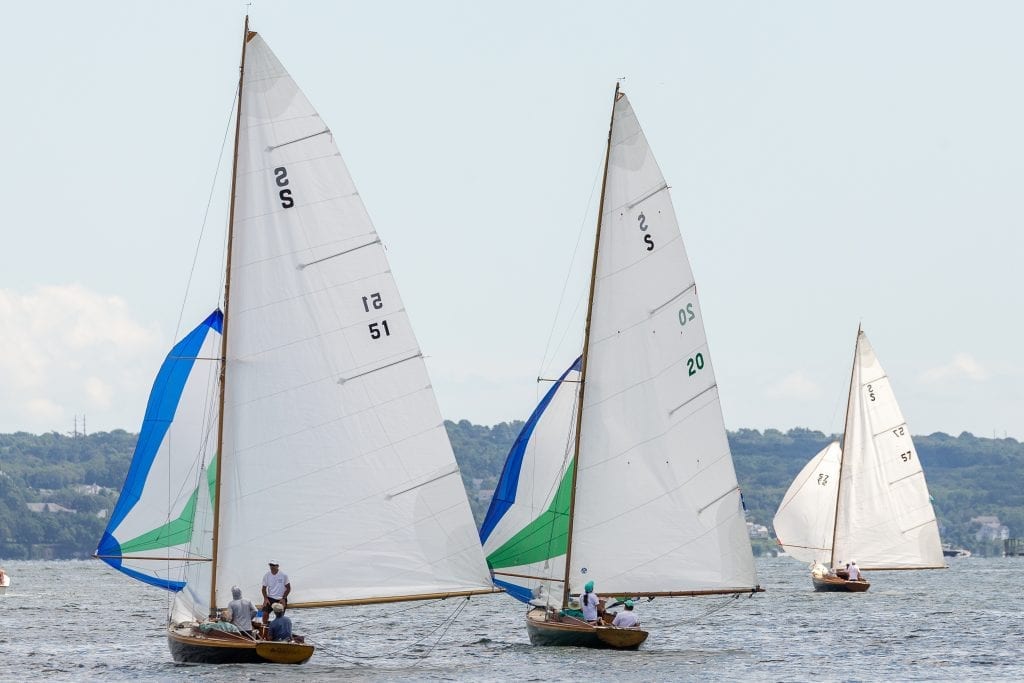

About Herreshoff S Class
HERRESHOFF MARINE MUSEUM HONORS 100TH ANNIVERSARY OF THE S-CLASS
2020 marks the 100th anniversary of the first Herreshoff S-Class boat that splashed in the waters off Bristol, Rhode Island in 1919. The S Class Centennial Herreshoff Classic Regatta, held at the Herreshoff Marine Museum in Bristol, Rhode Island last August 2019 highlighted the S-Class in honor of its anniversary. As many as 28 of these splendid yachts participated in the event.
Transcending the competition of the races, the splendor of such a large fleet of magnificent S-Class yachts sailing together will be a very special occasion for both sailors and spectators. Three Fleets were represented. Quissett Harbor Herreshoff S Class, Western Long Island Herreshoff S Class and the Narragansett Bay Herreshoff S Class.
By any measure, the S-Class is unique among yachts. Designed by the “Wizard of Bristol,” Captain Nat Herreshoff, perhaps the most renowned American naval architect ever. The S-Class was, and still is, one of Herreshoff’s most remarkable concepts. While Herreshoff is best known for his highly successful America’s Cup yachts, his innovative mind did not rest when it came to the finishing touches on this relatively small 28-foot yacht. From the unique graceful curve of the mast, the proud shape of the bow, the eye-pleasing overhang of the stern, to the remarkable contour of the keel, there is nothing ordinary about the design of the S boat.
Although there were only about a hundred S boats built between 1919 and 1940, many of the original boats are still actively racing in highly competitive in large regattas. While there are older one design class boats in the United States, the S-Class is the oldest one design still sailing in the original boat and rig of all wood construction. The fact that S boats continue to be viable and exciting to sail and race is a testament to how well they have stood the test of time. Even by today’s standards, they have design features that are remarkably modern, which has a lot to do with their ability to compete successfully against contemporary racing sailboats.
S boats are easily distinguished by a striking curve in the mast, which may appear to be sharply raked aft. In fact, the spar has a built-in curve that may have been an attempt to emulate a gaff rig. Remember, the S -Class was the first Marconi rig Herreshoff designed. The curved mast allows for some unique adjustments to the sail shape and sailing performance.
S boats are the closest thing to a pure-bred true sailor’s dream boat for sailing performance. The boats are fast in light wind due to the large sail area, and they handle very well and remain extremely stable in a strong breeze due to the full lead keel and the design of the curved mast. The boat sails very close to the wind with a small self-tending jib. S boats fly downwind under spinnaker, which requires a skilled crew to coordinate handling spinnaker lines, halyards, running backstays, and sheets all simultaneously.
S-Class yachts bear a fair ballast of mystique. Many a racing sailor has been seen scratching his head or mumbling in disbelief as he stares at the wooden transom of an S boat pulling away on a 20-mile race to Block Island, or a 19-mile race around Jamestown Island. Perhaps the true secret to the success of the S-Class remains in Captain Nat’s unrivaled eye for yacht design.
Fred Roy Commodore, Narragansett Bay Herreshoff S Class Association 2020
Boats Produced: 103
Class boat builder(s):
Herreshoff Manufacturing George Lawley and Son US Navy
Approximately how many boats are in the USA/North America? 66
Where is your One-Design class typically sailed in the USA? List regions of the country:
Does this class have a spinnaker or gennaker? Yes
How many people sail as a crew including the helm? 4
Ideal combined weight of range of crew: 650
Boat Designed in 1919
Length (feet/inches): 27’6″
Weight of rigged boat without sails: 6375
Draft: 4’9″
Mast Height: 37’0″
Class Rules (PDF Doc)
Back to One-Design Central
Copyright ©2018-2024 United States Sailing Association. All rights reserved. US Sailing is a 501(c)3 organization. Website designed & developed by Design Principles, Inc. -->
Great choice! Your favorites are temporarily saved for this session. Sign in to save them permanently, access them on any device, and receive relevant alerts.
- Sailboat Guide
Herreshoff S-Class
Herreshoff S-Class is a 27 ′ 5 ″ / 8.4 m monohull sailboat designed by Nathaniel G. Herreshoff and built by Lawley (George Lawley & Son) and Herreshoff Mfg. Co. between 1919 and 1941.

Rig and Sails
Auxilary power, accomodations, calculations.
The theoretical maximum speed that a displacement hull can move efficiently through the water is determined by it's waterline length and displacement. It may be unable to reach this speed if the boat is underpowered or heavily loaded, though it may exceed this speed given enough power. Read more.
Classic hull speed formula:
Hull Speed = 1.34 x √LWL
Max Speed/Length ratio = 8.26 ÷ Displacement/Length ratio .311 Hull Speed = Max Speed/Length ratio x √LWL
Sail Area / Displacement Ratio
A measure of the power of the sails relative to the weight of the boat. The higher the number, the higher the performance, but the harder the boat will be to handle. This ratio is a "non-dimensional" value that facilitates comparisons between boats of different types and sizes. Read more.
SA/D = SA ÷ (D ÷ 64) 2/3
- SA : Sail area in square feet, derived by adding the mainsail area to 100% of the foretriangle area (the lateral area above the deck between the mast and the forestay).
- D : Displacement in pounds.
Ballast / Displacement Ratio
A measure of the stability of a boat's hull that suggests how well a monohull will stand up to its sails. The ballast displacement ratio indicates how much of the weight of a boat is placed for maximum stability against capsizing and is an indicator of stiffness and resistance to capsize.
Ballast / Displacement * 100
Displacement / Length Ratio
A measure of the weight of the boat relative to it's length at the waterline. The higher a boat’s D/L ratio, the more easily it will carry a load and the more comfortable its motion will be. The lower a boat's ratio is, the less power it takes to drive the boat to its nominal hull speed or beyond. Read more.
D/L = (D ÷ 2240) ÷ (0.01 x LWL)³
- D: Displacement of the boat in pounds.
- LWL: Waterline length in feet
Comfort Ratio
This ratio assess how quickly and abruptly a boat’s hull reacts to waves in a significant seaway, these being the elements of a boat’s motion most likely to cause seasickness. Read more.
Comfort ratio = D ÷ (.65 x (.7 LWL + .3 LOA) x Beam 1.33 )
- D: Displacement of the boat in pounds
- LOA: Length overall in feet
- Beam: Width of boat at the widest point in feet
Capsize Screening Formula
This formula attempts to indicate whether a given boat might be too wide and light to readily right itself after being overturned in extreme conditions. Read more.
CSV = Beam ÷ ³√(D / 64)
Commissioned by Seawanhaka Corinthian Y.C., Oyster Bay, NY, and developed as a one-design class, it was also eligible to compete with an ‘S Class’ handicap as defined by the Universal Rule. At last report (2006) at least 70 were still sailing.
Embed this page on your own website by copying and pasting this code.
- About Sailboat Guide
©2024 Sea Time Tech, LLC
This site is protected by reCAPTCHA and the Google Privacy Policy and Terms of Service apply.
Open: Tues-Sat: 10-5pm, Sun: 12-5pm | Donate to the Museum

Western Long Island Sound Herreshoff S Class Association: Centennial Reflections
HERRESHOFF STORIES
From WIndCheck Magazine

Written by By Ted Burt, Alan Haigh and Douglas Cooper
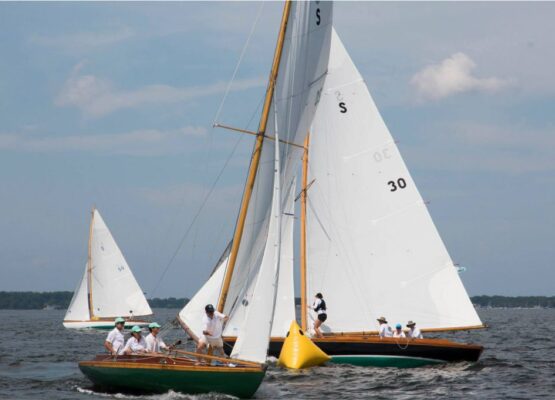
This is part of our ongoing series with our Jubilee Media Partner, WindCheck Magazine and originally appeared in the June 2021 Issue.
By Wendy Popp-Simmons , Allegro S20
“Everything should be made as simple as possible, but no simpler. – Attributed to Albert Einstein, circa 1920
Currently, much is being written about the brilliant design and aesthetic of Nathanael Herreshoff’s S Boat. For the skippers and crews of the Western Long Island Sound Herreshoff S Class Association (WLISHSCA), the affection and esteem carries into this 2021 season in the wake of an auspicious Centennial Anniversary for this one-design.
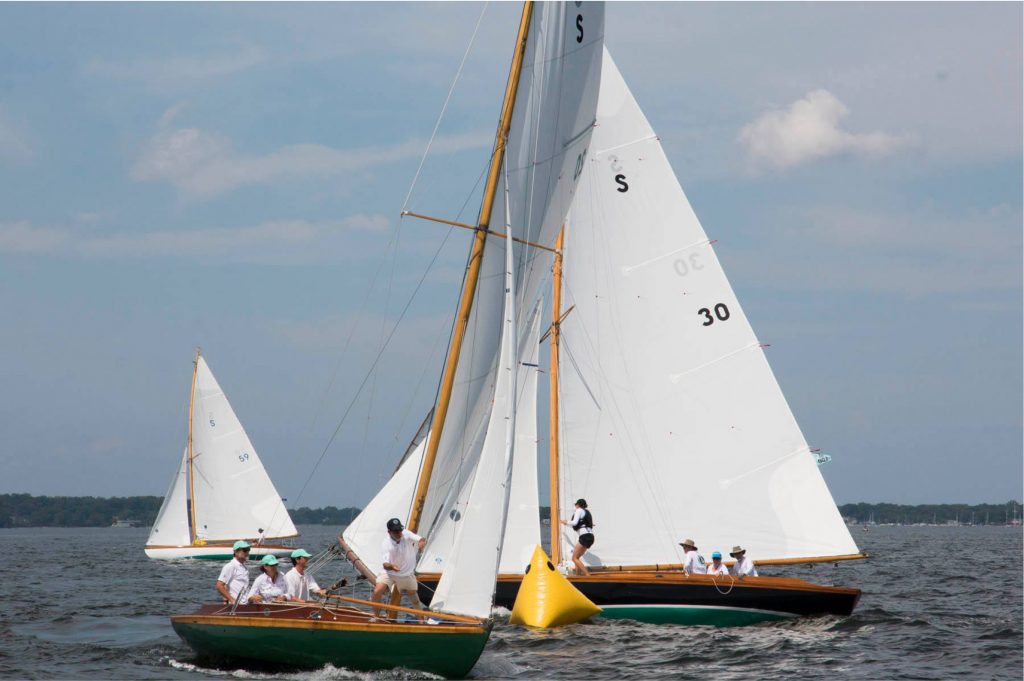
Allegro rounds a mark during the inaugural S Class Centennial Regatta, with Vindex in pursuit. © Emily Ferguson
`The highlight of the sailing season could arguably be the summer convergence of vessels for Larchmont Race Week. The annual festivities are extraordinary, and their welcome of the S Class fleets was exceptional. Not since Larchmont Race Week in 1947 had there been such a communing of this class on the waters of Western Long Island Sound. Fifteen S Boats coursed across the horizon, each trimmed to fill a captivating 340 square feet of mainsail with temperate Long Island Sound breezes. These wings are distinctive as they are usually trimmed for performance behind a 42-foot, gently curved Sitka spruce mast. The appearance is a striking triangular banner of canvas, the foot of which extends nearly eighteen feet along a formidable boom.
`Spectators watched the spoon bows carve into gentle waves while the fleet traversed New York waters. To the south, a crisp silhouette of New York City formed a distinguished backdrop. Each boat arrived to cheers from the crews of her sisters on an incandescent July morning. As greetings became punctuated by the familiar exclamation, “Backstay!” crews snapped out of their pleasant distraction to correct the significant and idiosyncratic feature of this craft.
On approach, one could appreciate the signature classic sheer strakes, newly varnished and gleaming. Grins of recognition between old friends, wry smiles creasing the crows’ feet of sun-weathered faces; skippers, crew, and family, full of anticipation and generating palpable warmth. Celebratory caps in turquoise were raised in salute as Surprise , Vindex , Pirate and Mischief from Narragansett Bay joined Teaticket , Coyote and Radiant from Quissett, Allegro , Phoenix , Kandahar II , Dilemma , Ingwe and Iroquois from Western Long Island Sound, and Dolcefariente from Virginia, their crews enthusiastically marking this historic occasion.
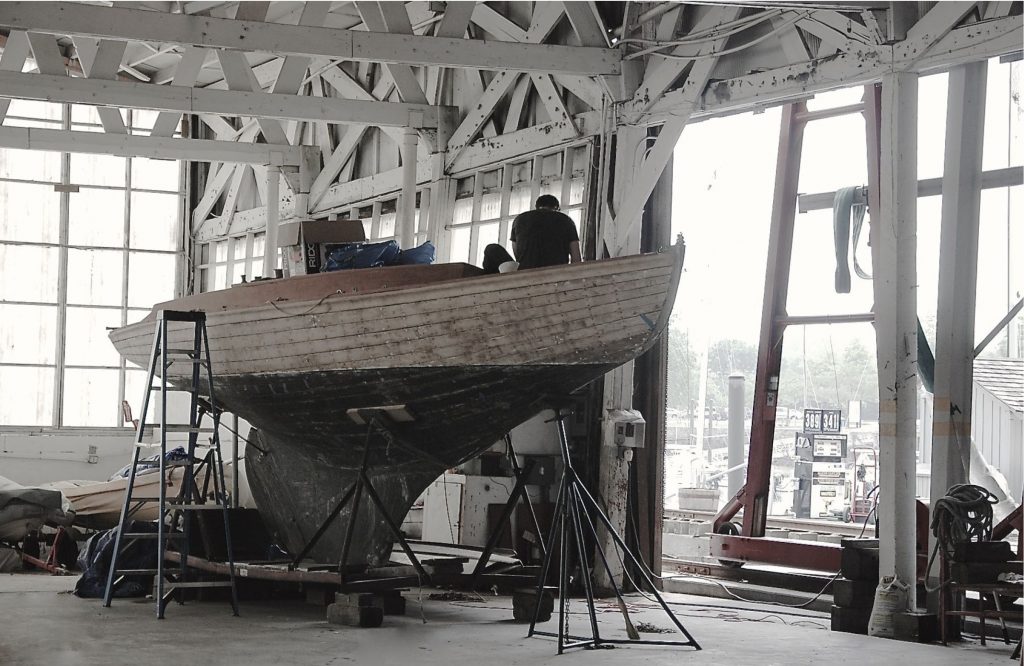
Wistful was lovingly by skipper Pierre Pascal Bardoux and renamed Ingwe.
Captain Nat Herreshoff carved the S boat half model in November 1919. On December 17, 1919, the very first order for an S Class One Design was placed by Paul Hammond of Seawanhaka Corinthian Yacht Club in Oyster Bay, NY. Hammond will never know how prescient his request would be!
One could infer that the first S Boat to arrive, S pinster (Hull 830), was indeed the comfortable solution between cruising and racing for a daysailer that Hammond had anticipated. Apparently, the design was successful enough to have a total of eighteen racing in Marblehead and Seawanahaka fleets by 1920. A series was instituted for women, wives, and daughters of the S Class in 1922. Thus began a tradition of these boats being owned and raced by subsequent generations in sailing families and the beginnings of the legacy of what many now consider the epitome of one-design racing.
The WLISHCA has a number of such family ownerships. It is this author’s impression that this fact is integral to the enduring appeal of this craft. The owners themselves are no less charismatic, with traits that mirror the vessel. Many are understated craftsmen, makers, architects, builders, or artists. Others are musicians, archivists, and people with a keen appreciation for a beautifully turned piece of wood and cast bronze hardware. With a love of precision and simplicity, they are quite meticulous, intuitive, resourceful, and often irrepressible.
When you take in the culture of the Herreshoff S Boat, you cannot help but admire the touch of warmth, tradition, and a style that cannot be duplicated in any other way other than by hand. If you doubt that “it is true of every art that you cannot acquire what you have not felt,” then a daysail on an S Boat might convince you.
The care is daunting in early spring but is met with deep satisfaction when the crews and family faces are mirrored in a beautifully painted hull. Each season brings on the prepping in the company of other such enthusiasts and eccentrics and of course those skeptics who do not see the functionality of wood in a boat until of course, they witness an S Boat being launched; a beautiful sight to behold. Each spring for many decades, Brewer Post Road Boat Yard in Mamaroneck, NY where all of the local S Boats await their annual polish, takes on an air of camaraderie rivaling what takes place on the water.
The owners, family, and crew do not shy from the tasks and exceptional demands of wooden boat ownership. Everyone anticipates seeing each other, working, learning together, and preserving these vintage crafts with a tenderness that is almost tribal. This author witnessed firsthand the entire restoration of the former Wistful by skipper Pierre Pascal Bardoux, who singlehandedly stripped her to her bones, rebuilt, replaced, and lovingly restored every inch of her over the course of a single season in 2015, renaming her Ingwe . He devoted three winters to further honing.
This is not to suggest that these characters are not competitive. The competition increases each year as crews gain skill and the discipline creates choreography and accuracy. When the breezes warm and fill in, these teams are enamored as the keel digs into its favorite groove, the balance settles just right with the tiller responding to the most delicate touch, and the boat finds its sweet spot.
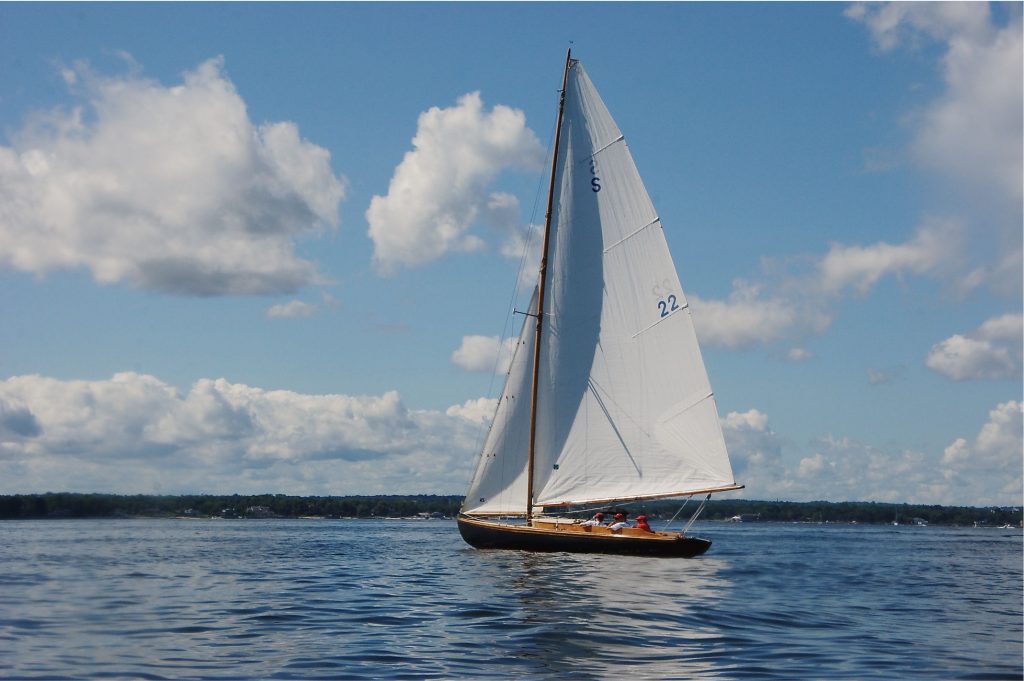
The crew of Bob Mehlich’s Kandahar II waits for breeze during the S Class Centennial Regatta at Larchmont Yacht Club.
Bob Mehlich, who skippers Kandahar II , reflects that the most alluring factors for his forty-three years of stewardship are “the camaraderie of the people I met plus the overall beauty and comfort of the S Boat.” Among our most accomplished skippers, Bob served as WLISHCA Commodore for nearly a decade. He and his brother-in-law Rick Beck, the skipper of Iroquois , have competed and raced together out of Larchmont Yacht Club for four decades.
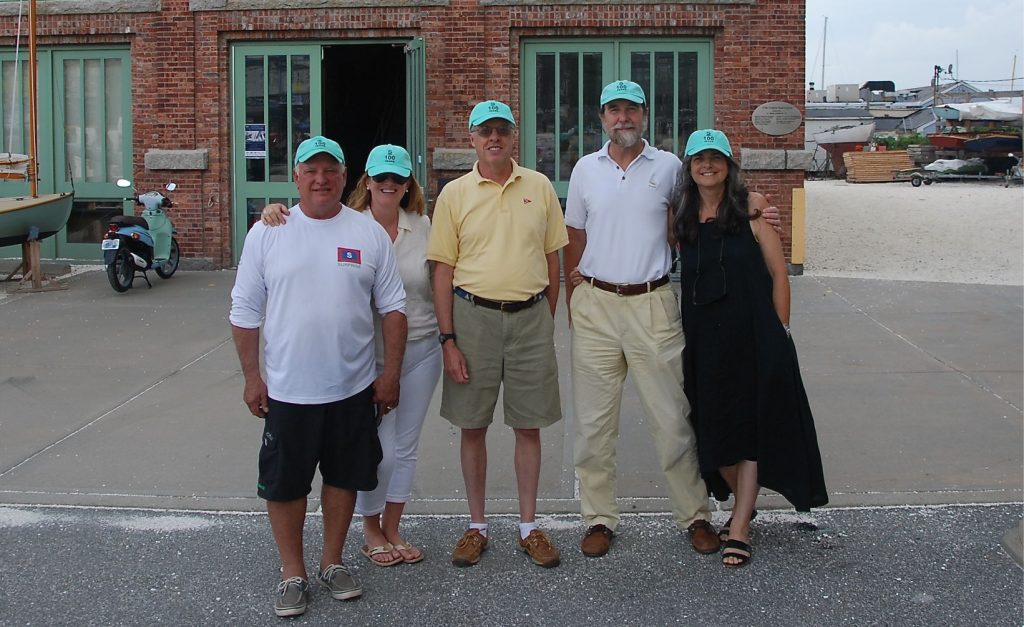
Pictured at the IYRS School of Technology & Trades in Newport, RI where they met to plan the S Class Centennial are (l r) Commodore Fred Roy, Nancy Roy, Commodore Doug Cooper, Commodore Bill Simmons, and author Wendy Popp-Simmons.
Bob has experienced some of the more harrowing blows. Despite two dismastings and two storms that lifted his boats from their moorings, Mehlich and his first mate and son Robbie persist. “When I first started skippering the boat in 1978, we got hit by a storm during a race,” he recalls. “It blew so hard and rained so hard that visibility was a couple feet. I headed into what I thought was the harbor, but left both my sails up. I was unable to come about as the boom was in the water. Needless to say, we were headed for the breakwater. Somehow, I was able to get the boat to come about at the last minute before hitting the rocks. Of course, I did not have the sails properly trimmed due to my inexperience…and my crew was as green as the color of the sky that day!”
Any sailor would appreciate the immediate grace in the turn that an S Boat makes around a mark! The keel is composed of 3,350 pounds of lead, making the boat exceptionally fast. The motion is breathtaking in a close rounding. But it is the S Boat owner who looks up, while sanding and smoothing the surface of the keel, to admire its curvature and sculptural beauty. One imagines Captain Nathanael Greene Herreshoff and his brother John Brown Herreshoff conjuring those dimensions over a century ago, the half hull in their hands, taking full measure of the performance through its shape and feel.
Captain Nat’s meticulous design studio is beautifully preserved at the Herreshoff Marine Museum in Bristol. When viewing the vast collection of half hulls on the walls, a quote attributed to da Vinci might come to mind: “Where the spirit does not work with the hand, there is no art.”
Captain Nat’s son, L. Francis Herreshoff, once stated that there have been few all-around better boats for afternoon sailing, cruising and racing than the S Class, also noting they were also the last one-design class that was somewhat comfortable, and perhaps the most interesting design developed in 1919, amidst all of the innovation going on at that time.
The roster of owners and the length of its legacy have established that this vessel is perhaps the most successful of Herreshoff’s One Designs, while we also recognize the enduring Herreshoff 12 ½. During a recent exhibition at the MIT Museum called Lighter, Stronger, Faster: The Herreshoff Legacy , the S Class was exceptionally noted and celebrated.
Many of the clubs on Long Island Sound have embraced the design. American Yacht Club in Rye, NY boasted fourteen S Boats through the thoughtful acquisitions made by Dr. James Benfield. The first year that they were noted to race was in 1939. The racing roster peaked at thirty-four boats. Were it not for a world war and a savage fire in 1958, their numbers would have profoundly increased. Despite those setbacks, a racing fleet managed to persevere. Many of the original skippers have owned and raced their boats for decades through extremely challenging times.
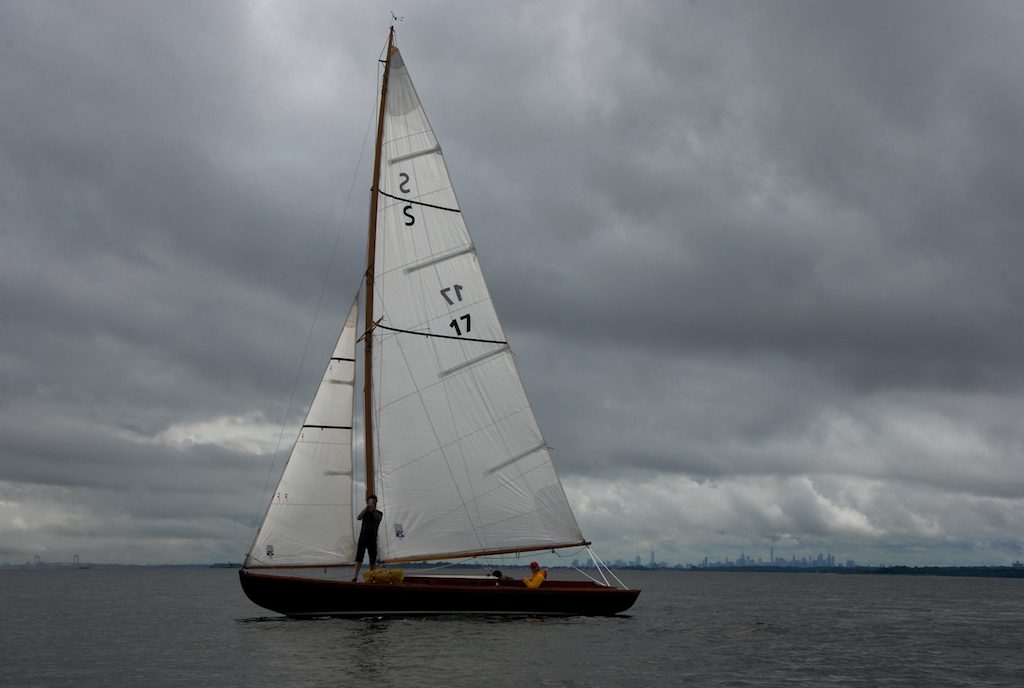
The combined S Class Associations had the opportunity to celebrate one of WLISHCA’s more venerate members; class archivist and intrepid competitor, the late George Hanson. Hanson was distinguished by his induction into the Herreshoff S Class Hall of Fame. Throughout his nearly sixty-four years of skippering Phoenix , it was his encouragement and role of fostering a number of abandoned S Boats and his personal sense of duty to enlist new owners have helped sustain the WLISHCA as we know it today. His son and daughter-in-law, Eric Hanson and Daniele Rudi, will now share the helm and continue his legacy when Phoenix splashes this year.
The Western Long Island Sound Herreshoff S Class Association has the honor of having cultivated a number of the S Class Hall of Fame Honorees. The fleet trophies bear the names of highly celebrated skippers of such crew and families that are etched in silver dating back to 1950.
John Judge sailed Celebrity through the 1950s and ’60s to achieve his distinguished position. He and George Hanson accepted this honor on the deck of Horseshoe Harbor Yacht Club in Larchmont, NY, where Phoenix has moored since 1956. Horseshoe Harbor is home to four S Boats.
Brian Kelly is rumored to have singlehandedly raced the winning Eaglet , S57 on a number of occasions over the decades that he sailed into his notoriety. He was inducted posthumously in 2011.
The current owners of Eaglet are Kirsty Scott and Adrian McKimmey. Scott recently reflected, “George Hanson introduced us to the S boat when we first became members of HHYC in 2006. We bought her from Brian Kelly’s nephew, Sean Daly in September 2008. George Hanson brokered the deal. We sailed up to Seawanhaka Corinthian Yacht Club, where Eaglet was originally commissioned. It was a beautiful sail up there, but we were anxious to make it before dark. We had no idea where to find our guest mooring, but Eaglet seemed to know the way. The sun had gone down, it was hushed and the wind had quieted. We dropped the sail and she glided up to a mooring as if we had nothing to do with it. She had returned home. It all felt effortless and magical. When we had dinner in the clubhouse that evening, we saw photos of Eaglet (with her previous owner Brian Kelly on board) and a photo of one of the only female S boat skippers from the 1930s.”
Another captain of Eaglet and an earlier inductee was Matty Burgraff; Eaglet and Burgraff’s name adorn the first place etchings on WLISHCA’s Burgraff trophy consistently throughout the history of the fleet.
Howard Howard, devoted skipper and owner of the highly awarded Allegro S20 since 1967, partnered for eighteen years with Commodore Bill Simmons. Howard was inducted into the Hall of Fame during the 2019 festivities. It was Howard and Simmons who introduced this author to the language of the S Boat, and have since helped to wean first mate and foredeck crew Wynn Simmons into the art of seamanship.
The award to Howard was presented on Saturday, August 17, 2019 at the Centennial Events at Sail Newport. Howard has been a devoted steward of Allegro for 54 years.
Indeed, it is a curious fact that Narragansett Bay’s own Commodore Fred Roy mentioned that he “cut his teeth” on WLISHSCA’s Danae , owned by Bill Riley, racing the waters of Long Island Sound!
Six of WLISCA’s skippers had celebrated the 75th anniversary of these stalwart crafts together and were thrilled to toast and roast each other during the highly anticipated 100th year.
Dilemma S59 is now owned by Sean Park, who was introduced to sailing when his father held the helm of Hornpipe . Sean had since been the Commodore of the WLISHSCA fleet for a few years and had taken on the role of savior to abandoned vessels to help enlist new S Class family members during his stead.
The use of the word “family” is not used loosely here.
Commodore Simmons reflects, “When my eldest child, my daughter Zoe, was in grade school, there was a class project in which I participated. I was asked to make an image of a goal of mine. I made a little colored drawing of Zoe and myself in a sailboat heading toward shore and my wife holding a baby boy.”
“I often reflect on the fact that everything in that dream came true and still love those times when my family, or any part thereof, is on board our Allegro . The baby in my dream, my son who is now grown, has taken to sailing in a large way and holds a special affinity for the precious heritage these beautiful little yachts, the S Boats, represent. He and my wife, Wendy, have been my most steady and reliable crew which has led to great success in our local fleet racing over the years. Allegro has been a family binder. Of all the joys she has provided due to her elegance, power, comfort, and access to our Long Island Sound, her role as a family binder is what I hold most dear.”
Dilemma ’s first mate Shane C. Parouse wrote, “I was first introduced to the S Class by Jim Park, owner of Hornpipe , in the mid-‘80s. I was a teenage friend of his sons Lorne and Sean and invited out to help ‘crew’ on the boat for a race. Jim kept his boat in Hempstead Harbor, sitting on a mooring by a dreadfully dangerous rock that was submerged at high tide. We got out to Hornpipe in a dinghy that was stored onshore and had to be carried down to the beach, flipped over, boarded without incident, and rowed out to the boat.
“I sailed like this a handful of times with Jim, missing my backstays (the only task I was trusted with), and riding along completely confused about what was going on. But somehow I was hooked anyway. I remember sitting on the lawn at Larchmont Yacht Club after a Race Week day, eating burgers and ice cream. As a kid from Brooklyn who was once on food stamps, you can rest assured I had never been to a yacht club before, but of course, the beauty of the setting is vivid in my mind to this day. Jim, Lorne, and Hornpipe opened up a new world to me.
“I also remember a long ride home one day, in the fog, when we narrowly avoided running into the Hempstead Harbor breakwater only because we could hear waves crashing into it!
I didn’t sail again for fifteen years, until after 9/11, when I needed a distraction from the realities of the world and took my ASA 101 course at New York Sailing School in New Rochelle. Within a few years, I was reconnected with Sean Park, who had returned to New York and was looking to crew up on Alex von Bidder’s Dilemma .
“The rest is history, as we’ve sailed together for fifteen years now. At first we were horrible, but with a competitive drive and eagerness to learn, we won championships, caught an anchor on deck from a leisure boat on the course, competed in the 100th Anniversary regatta, and had an absurd number of good laughs.
“Sailing, the S Boat, and the experiences and friends I have made throughout the years has been one of the great pleasures of my life, and my family now has a boat of our own. It’s given me access to a pastime we will continue to enjoy for many years to come.”
Since the whole of this reflection was asked to be specific to Western Long Island Sound and its current fleet, it would be remiss to speak of the Centennial and the fleet without mentioning how synonymous the character of the skippers, crew, and families are with these craft. It truly is as if the boat has chosen them. When at the helm, there is a fluid connection between the skippers and their boats. It is beautiful to witness a knowledgeable sailor take hold and watch their face soften into a blissful thoughtfulness while they guide this powerful rig with a weightless touch.
When asked about his memorable and most harrowing experiences on Danae , venerate WLISHCA skipper Bill Riley recalls, “I loved sailing my wooden 14-foot Old Town White Cap on Candlewood Lake until Danae and Long Island Sound directed my life. Racing with family and all the wonderful friends and sailors we have met over the last forty-seven years has been a blessing. The memories are too numerous to count. The most harrowing experience has been buying the S Boat in the first place.”
Allegro S20, Phoenix S10, Kandahar II S22, Dilemma S59, Ingwe S6, Danae S68 and Iroquois S17 are making ready to sail this spring season. The entire class performed in outstanding fashion on their 100th birthday. WLISHCA’s Allegro , skippered by Commodore Bill Simmons, took fourth in the inaugural event in her waters. The fleet from Narragansett Bay dominated the series, with Vindex , skippered by Paul Del Nero, earning the overall win, Pirate , skippered by Bob Patterson, taking second and Surprise , skippered by Commodore Roy, finishing third.
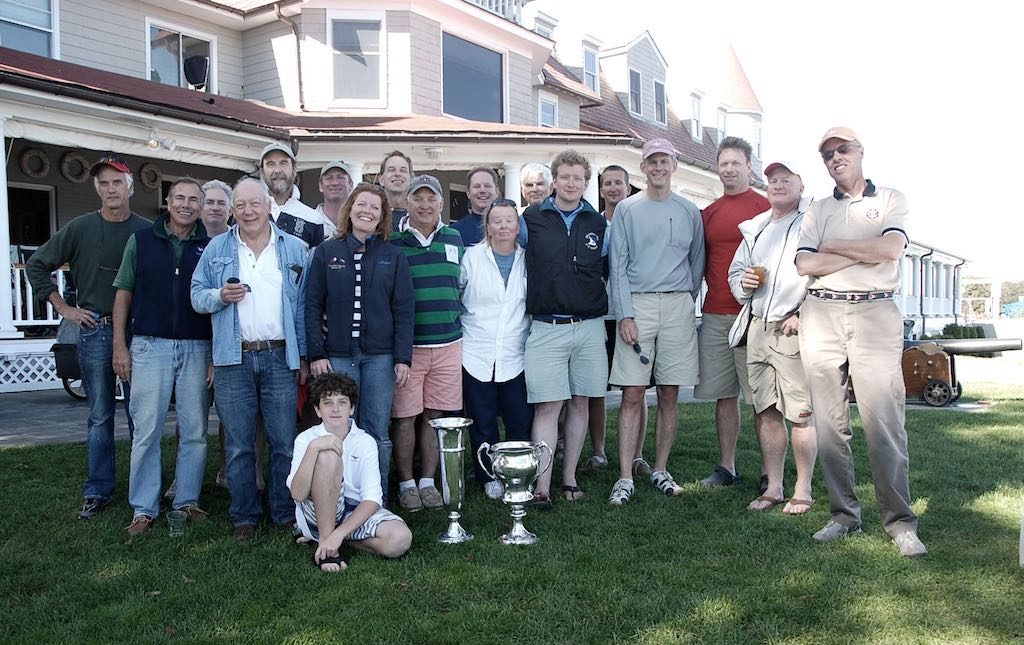
For those devoted to the S Class, there is a wistful acknowledgment of having been part of something greater in the act of shepherding these wonderful vessels forward into this century.
In a recent letter to Commodore Bill Simmons, Halsey C. Herreshoff related that perhaps we do not fully understand that when his grandfather, Captain Nat, designed the S Boats in late 1919, he was quite stressed by illness and overwork preparing Resolute for the 1920 America’s Cup Match. “Nothing seemed to bother his brilliant designs, time after time. Of course, we all know and appreciate the fantastic proportions of the S Boats for brilliant sailing in light or strong breezes. But equally significant is his innovative rig, just at the threshold of what was then termed the ‘Leg-O-Mutton rig.’
“My Father, Sid Herreshoff, was the first to ever test sail an S Boat, in winter 1920. He told me that his father reasoned the curved mast, so simply and brilliantly built by the Herreshoff shop, was to provide additional sail support replacing that of previous gaff-riggers, so S Boats were clearly significant steps forward in his rapid replacement of gaff rigs.” Halsey Herreshoff finished by stating that he didn’t believe his grandfather ever expected that so many others would continue the “eager and brilliant racing” of these boats a century hence.
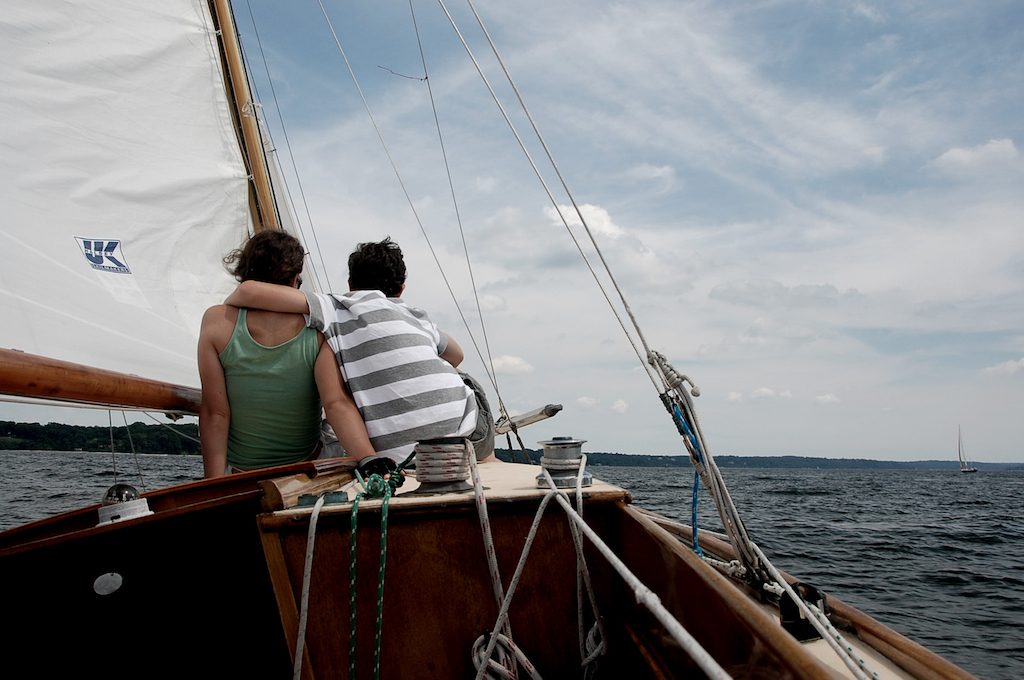
This crewmember would like to think that the birth of the S Class One Design was a by-product of that profound effort put forth during Nat Herreshoff’s flow state during such a stressful time. Working on the complexity of the extraordinary Resolute spawned the brilliance of simplicity and powerful design – our delightful day racer. Given the dedication of this S Boat culture, there is enough evidence to believe the S Class One Design vessels will carry on for generations to come.
More from WindCheck Magazine's Herreshoff Story Series
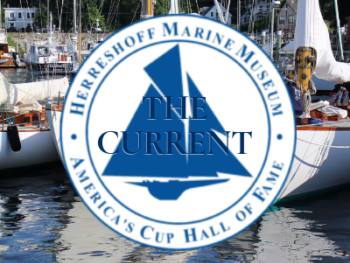
Share your Herreshoff Story.
We want to hear from our Herreshoff and America's Cup Hall of Fame Community.
Not logged in
Page actions.
- View source

- 1 Design and Construction Notes
- 2 S-1 and S-18 through S-29 (EB design built at Bethlehem Quincy)
- 3 S-2 (Lake design built at Lake Torpedo Boat Company)
- 4 S-3 through S-9 (Government design built at Portsmouth Navy Yard)
- 5 S-10 through S-13 (Modified Government design built at Portsmouth Navy Yard)
- 6 S-14 through S-17 (Government design built by Lake Torpedo Boat Company)
- 7 S-30 through S-41 (EB design built at Bethlehem San Francisco)
- 8 S-42 through S-47 (Modified EB design built at Bethlehem Quincy)
- 9 S-48 through S-51 (Modified Government design built by Lake Torpedo Boat Company)
- 10 S-class general and group photos
Design and Construction Notes
S-1 and S-18 through S-29 (EB design built at Bethlehem Quincy)
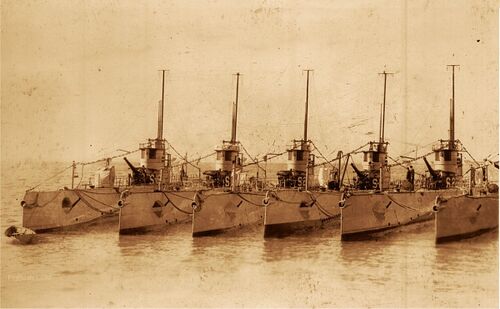
See more of this group
S-2 (Lake design built at Lake Torpedo Boat Company)
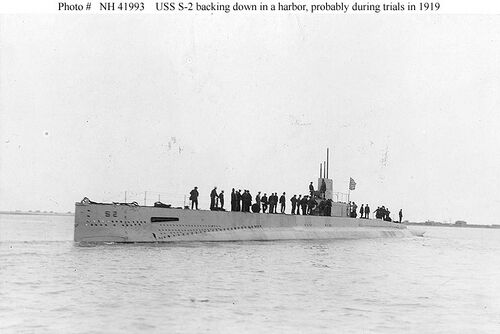
See more S-2 photos
S-3 through S-9 (Government design built at Portsmouth Navy Yard)

S-10 through S-13 (Modified Government design built at Portsmouth Navy Yard)

S-14 through S-17 (Government design built by Lake Torpedo Boat Company)
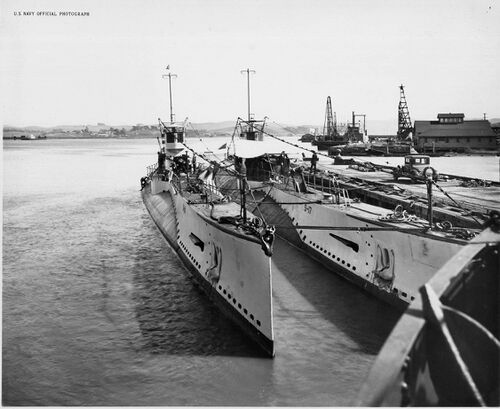
S-30 through S-41 (EB design built at Bethlehem San Francisco)
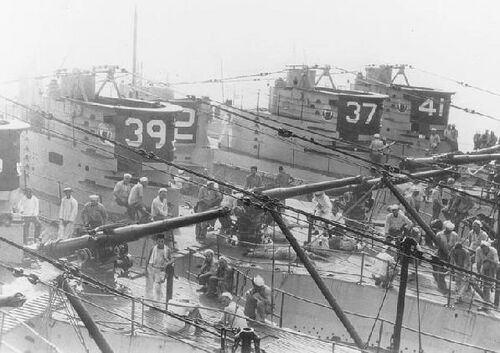
S-42 through S-47 (Modified EB design built at Bethlehem Quincy)

S-48 through S-51 (Modified Government design built by Lake Torpedo Boat Company)
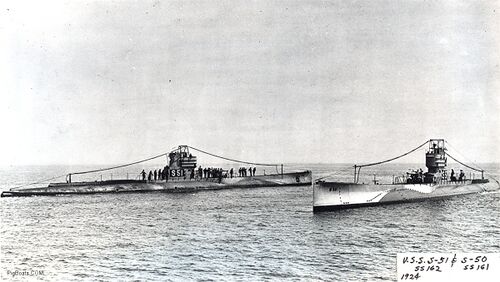
S-class general and group photos
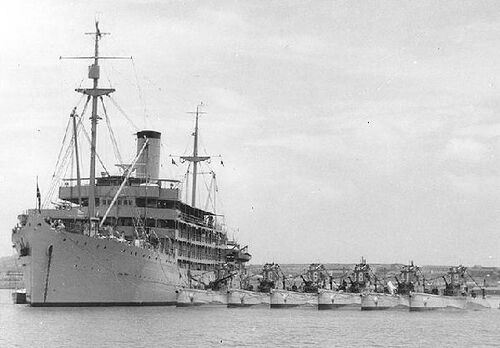
See more group photos
Page created by: Ric Hedman & David Johnston 1999 - 2023 - PigBoats.COM © Mountlake Terrace, WA, Norfolk, VA webmaster at pigboats dot com
- Latest Updates
- The Submarines
- What Is A PigBoat?
- Simon Lake Submarines
- Submarine Specifications
- Torpedoes of the Pigboat Era
- Commanding Officer Database
- Photo Features & Sea Stories
- Notable Submarine Accidents
- Submarine Plans and Blueprints
- Qualification Notebooks
- Research Articles
- A Good and Favorable Wind, our book!
- Submarine Poems
- The Submarine Tradition
- PigBoats Staff & Contact Info
- Recent changes
- Special pages
- Cite this page
User page tools
- What links here
- Related changes
- Printable version
- Permanent link
- Page information
- This page was last edited on 25 March 2024, at 18:47.
- Privacy policy
- About PigBoats.COM
- Disclaimers
17 Sailboat Types Explained: How To Recognize Them
Ever wondered what type of sailboat you're looking at? Identifying sailboats isn't hard, you just have to know what to look for. In this article, I'll help you.
Every time I'm around a large number of sailboats, I look around in awe (especially with the bigger ones). I recognize some, but with most of them, I'll have to ask the owner. When they answer, I try to hide my ignorance. The words don't make any sense!
So here's a complete list with pictures of the most common sailboat types today. For each of them, I'll explain exactly where the name comes from, and how you can recognize it easily.

So here's my list of popular sailboat types, explained:
Bermuda sloop, sailing hydrofoil, dutch barge, chinese junk, square-rigged tall ship, in conclusion, how to recognize any sailboat.
Before we get started, I wanted to quickly explain what you should look for when you try to identify a sailboat.
The type of sailboat is always determined by one of these four things:
- The type of hull
- The type of keel
- The number of masts
- And the type of sails and rig
The hull is the boat's body. There are basically three hull types: monohull, catamaran, and trimaran. Simply said: do I see one hull, two hulls (catamaran) or three hulls (trimaran)? Most sailboats are monohulls.
Next, there is the keel type. The keel is the underwater part of the hull. Mostly, you won't be able to see that, because it's underwater. So we'll leave that for now.
The sail plan
The last factor is the number of masts and the sail plan. The sail plan, simply put, is the number of sails, the type of sails, and how the sails are mounted to the masts (also called rigging ).
Sailboat are mostly named after the sail plan, but occasionally, a sail type is thrown in there as well.
So now we know what to pay attention to, let's go and check out some sailboats!

Dinghies are the smallest and most simple sailboats around.
They are your typical training sailboats. Small boats with an open hull, with just one mast and one sail. Perfect for learning the ways of the wind.
On average, they are between 6 and 20 ft long. Mostly sailed single-handed (solo). There's no special rigging, just the mainsail. The mainsail is commonly a Bermuda (triangular) mainsail. Dinghies have a simple rudder stick and no special equipment or rigging.
Dinghies are great for learning how to sail. The smaller the boat, the better you feel the impact of your trim and actions.
How to recognize a sailing dinghy:
- short (8ft)
- one Bermuda sail
- open hull design
- rudder stick
Common places to spot them: lakes, near docks

If you'd ask a kid to draw a sailboat, she'll most probably draw this one. The Bermuda Sloop is the most popular and most common sailboat type today. You'll definitely recognize this one.
How to recognize a Bermuda Sloop:
- triangular mainsail (called a Bermuda sail)
- a foresail (also called the jib)
- fore-and-aft rigged
- medium-sized (12 - 50 ft)
Fore-and-aft rigged just means "from front to back". This type of rigging helps to sail upwind.
Any sailboat with one mast and two sails could still be a sloop. Even if the sails are another shape or rigged in another way. For example, here's a gaff-rigged sloop (more on the gaff rig later):

If you want to learn all about sail rigs, check out my full Guide to Understanding Sail Rig Types here. It has good infographics and explains it in more detail
The Bermuda sloop has a lot of advantages over other sailboat types (which is why it's so popular):
- the Bermuda rig is very maneuverable and pretty fast in almost all conditions
- it's really versatile
- you can sail it by yourself without any problems
- it's a simple setup
Common places to spot a sloop: everywhere. Smaller sloops are more common for inland waters, rivers, and lakes. Medium-sized and large sloops are very popular cruising boats.

Cutters have one mast but three or more sails. Most cutters are Bermuda rigged, which means they look a lot like sloops.
How to recognize a cutter:
- looks like a sloop
- two or more headsails instead of one
- commonly one mast
- sometimes an extra mast with mainsail
Cutters have more sail area, which makes them faster, but also harder to sail single-handed. There's also more strain on the mast and rigging.
Common places to spot a cutter: everywhere. Cutters are very popular for cruising.
They mostly have a Bermuda rig, which means triangular sails. But there are also gaff cutters and naval cutters, and some have two masts.
Here's an example of a two-masted naval cutter with an extra gaff mainsail and top gaff:

The Hydrofoil is a pretty new sailboat design. It's a racing sailboat with thin wing foils under the hull. These lift up the hull, out of the water, reducing the displacement to nearly zero. The foils create downforce and keep it from lifting off entirely.
This makes the hydrofoil extremely fast and also impressive.
The hydrofoil refers to the keel type. There are both monohull and multihull hydrofoils.
How to recognize a hydrofoil:
- it flies above the waterline and has small fins
Common places to spot a hydrofoil: at racing events

Famous catamaran: La Vagabonde from Sailing La Vagabonde
A catamaran is a type of cruising and racing multihull sailboat with two hulls. The hulls are always the same size.
Most catamarans have a standard Bermuda rig. The catamaran refers to the hull, so it can have any number of masts, sails, sail types and rig type.
How to recognize a catamaran:
- any boat with two hulls is called a catamaran
Common places to spot catamarans: coastal waters, The Caribbean, shallow reefs
The advantages of a catamaran: Catamarans heel less than monohulls and are more buoyant. Because of the double hull, they don't need as deep a keel to be stable. They have a smaller displacement, making them faster. They also have a very shallow draft. That's why catamarans are so popular in the Caribbean, where there's lots of shallow water.
Catamarans are nearly impossible to capsize:
"Compared with a monohull, a cruising catamaran sailboat has a high initial resistance to heeling and capsize—a fifty-footer requires four times the force to initiate a capsize than an equivalent monohull." Source: Wikipedia

How to recognize a trimaran:
- any boat with three hulls is called a trimaran
Trimarans have three hulls, so it's a multi-hull design. It's mostly a regular monohull with two smaller hulls or floaters on the sides. Some trimarans can be trailered by winching in the auxiliary hulls, like this:

This makes them very suitable for long-term cruising, but also for regular docking. This is great for crowded areas and small berths, like in the Mediterranean. It sure is more cost-effective than the catamaran (but you also don't have the extra storage and living space!).
Common places to spot Trimarans: mostly popular for long-term cruising, you'll find the trimaran in coastal areas.

Gaffer refers to gaff-rigged, which is the way the sails are rigged. A gaff rig is a rectangular sail with a top pole, or 'spar', which attaches it to the mast. This pole is called the 'gaff'. To hoist the mainsail, you hoist this top spar with a separate halyard. Most gaffers carry additional gaff topsails as well.
Gaff rigs are a bit less versatile than sloops. Because of the gaff, they can have a larger sail area. So they will perform better with downwind points of sail. Upwind, however, they handle less well.
How to recognize a gaffer:
- sail is rectangular
- mainsail has a top pole (or spar)
Since a gaffer refers to the rig type, and not the mast configuration or keel type, all sailboats with this kind of rigging can be called 'gaffers'.
Common places to spot a gaffer: Gaffers are popular inland sailboats. It's a more traditional rig, being used recreationally.

Schooners used to be extremely popular before sloops took over. Schooners are easy to sail but slower than sloops. They handle better than sloops in all comfortable (cruising) points of sail, except for upwind.
How to recognize a schooner:
- mostly two masts
- smaller mast in front
- taller mast in the back
- fore-and-aft rigged sails
- gaff-rigged mainsails (spar on top of the sail)
Common places to spot a schooner: coastal marinas, bays

How to recognize a ketch:
- medium-sized (30 ft and up)
- smaller mast in back
- taller mast in front
- both masts have a mainsail
The ketch refers to the sail plan (mast configuration and type of rig). Ketches actually handle really well. The back mast (mizzenmast) powers the hull, giving the skipper more control. Because of the extra mainsail, the ketch has shorter masts. This means less stress on masts and rigging, and less heel.
Common places to spot a ketch: larger marinas, coastal regions

How to recognize a yawl:
- main mast in front
- much smaller mast in the back
- back mast doesn't carry a mainsail
The aft mast is called a mizzenmast. Most ketches are gaff-rigged, so they have a spar at the top of the sail. They sometimes carry gaff topsails. They are harder to sail than sloops.
The yawl refers to the sail plan (mast configuration and type of rig).
Common places to spot a yawl: they are not as popular as sloops, and most yawls are vintage sailboat models. You'll find most being used as daysailers on lakes and in bays.

Dutch Barges are very traditional cargo ships for inland waters. My hometown is literally littered with a very well-known type of barge, the Skutsje. This is a Frisian design with leeboards.
Skutsjes don't have a keel but use leeboards for stability instead, which are the 'swords' or boards on the side of the hull.
How to recognize a Dutch Barge:
- most barges have one or two masts
- large, wooden masts
- leeboards (wooden wings on the side of the hull)
- mostly gaff-rigged sails (pole on top of the sail, attached to mast)
- a ducktail transom

The clipper is one of the latest sailboat designs before steam-powered vessels took over. The cutter has a large cargo area for transporting cargo. But they also needed to be fast to compete with steam vessels. It's a large, yet surprisingly fast sailboat model, and is known for its good handling.
This made them good for trade, especially transporting valuable goods like tea or spices.

How to recognize a Clipper:
- mostly three masts
- square-rigged sails
- narrow but long, steel hull
Common places to spot a clipper: inland waters, used as houseboats, but coastal waters as well. There are a lot of clippers on the Frisian Lakes and Waddenzee in The Netherlands (where I live).

This particular junk is Satu, from the Chesapeake Bay Area.
The Chinese Junk is an ancient type of sailboat. Junks were used to sail to Indonesia and India from the start of the Middle Ages onward (500 AD). The word junk supposedly comes from the Chinese word 'jung', meaning 'floating house'.
How to recognize a Chinese junk:
- medium-sized (30 - 50 ft)
- large, flat sails with full-length battens
- stern (back of the hull) opens up in a high deck
- mostly two masts (sometimes one)
- with two mainsails, sails are traditionally maroon
- lug-rigged sails
The junk has a large sail area. The full-length battens make sure the sails stay flat. It's one of the flattest sails around, which makes it good for downwind courses. This also comes at a cost: the junk doesn't sail as well upwind.

The cat rig is a sail plan with most commonly just one mast and one sail, the mainsail.
Most sailing dinghies are cats, but there are also larger boats with this type of sail plan. The picture above is a great example.
How to recognize a cat rig:
- smaller boats
- mostly one mast
- one sail per mast
- no standing rigging
Cat-rigged refers to the rigging, not the mast configuration or sail type. So you can have cats with a Bermuda sail (called a Bermuda Cat) or gaff-rigged sail (called a Gaff Cat), and so on. There are also Cat Ketches and Cat Schooners, for example. These have two masts.
The important thing to know is: cats have one sail per mast and no standing rigging .
Most typical place to spot Cats: lakes and inland waters

Famous brig: HMS Beagle (Charles Darwin's ship)
A brig was a very popular type of small warship of the U.S. navy during the 19th century. They were used in the American Revolution and other wars with the United Kingdom. They carry 10-18 guns and are relatively fast and maneuverable. They required less crew than a square-rigged ship.
How to recognize a brig:
- square-rigged foremast
- mainmast square-rigged or square-rigged and gaff-rigged

How to recognize a tall ship:
- three or four masts
- square sails with a pole across the top
- multiple square sails on each mast
- a lot of lines and rigging
Square-rigged ships, or tall ships, are what we think of when we think of pirate ships. Now, most pirate ships weren't actually tall ships, but they come from around the same period. They used to be built from wood, but more modern tall ships are nearly always steel.
Tall ships have three or four masts and square sails which are square-rigged. That means they are attached to the masts with yards.
We have the tall ship races every four years, where dozens of tall ships meet and race just offshore.
Most common place to spot Tall Ships: Museums, special events, open ocean

This is a bonus type since it is not very common anymore. As far as I know, there's only one left.
The Trabaccolo is a small cargo ship used in the Adriatic Sea. It has lug sails. A lug rig is a rectangular sail, but on a long pole or yard that runs fore-and-aft. It was a popular Venetian sailboat used for trade.
The name comes from the Italian word trabacca , which means tent, referring to the sails.
How to recognize a Trabaccolo:
- wide and short hull
- sails look like a tent
Most common place to spot Trabaccolo's: the Marine Museum of Cesenatico has a fully restored Trabaccolo.
So, there you have it. Now you know what to look for, and how to recognize the most common sailboat types easily. Next time you encounter a magnificent sailboat, you'll know what it's called - or where to find out quickly.

I loved this article. I had no idea there were so many kinds of sailboats.
i have a large sailing boat about 28ft. that im having a difficult time identifying. it was my fathers & unfortunately hes passed away now. any helpful information would be appreciated.
Jorge Eusali Castro Archbold
I find a saleboat boat but i can find the módem…os registré out off bru’x, and the saleboat name is TADCOZ, can you tell me who to go about this matter in getting info.thank con voz your time…
Leave a comment
You may also like, guide to understanding sail rig types (with pictures).
There are a lot of different sail rig types and it can be difficult to remember what's what. So I've come up with a system. Let me explain it in this article.

The Ultimate Guide to Sail Types and Rigs (with Pictures)

How Much Sailboats Cost On Average (380+ Prices Compared)

Adult Programs
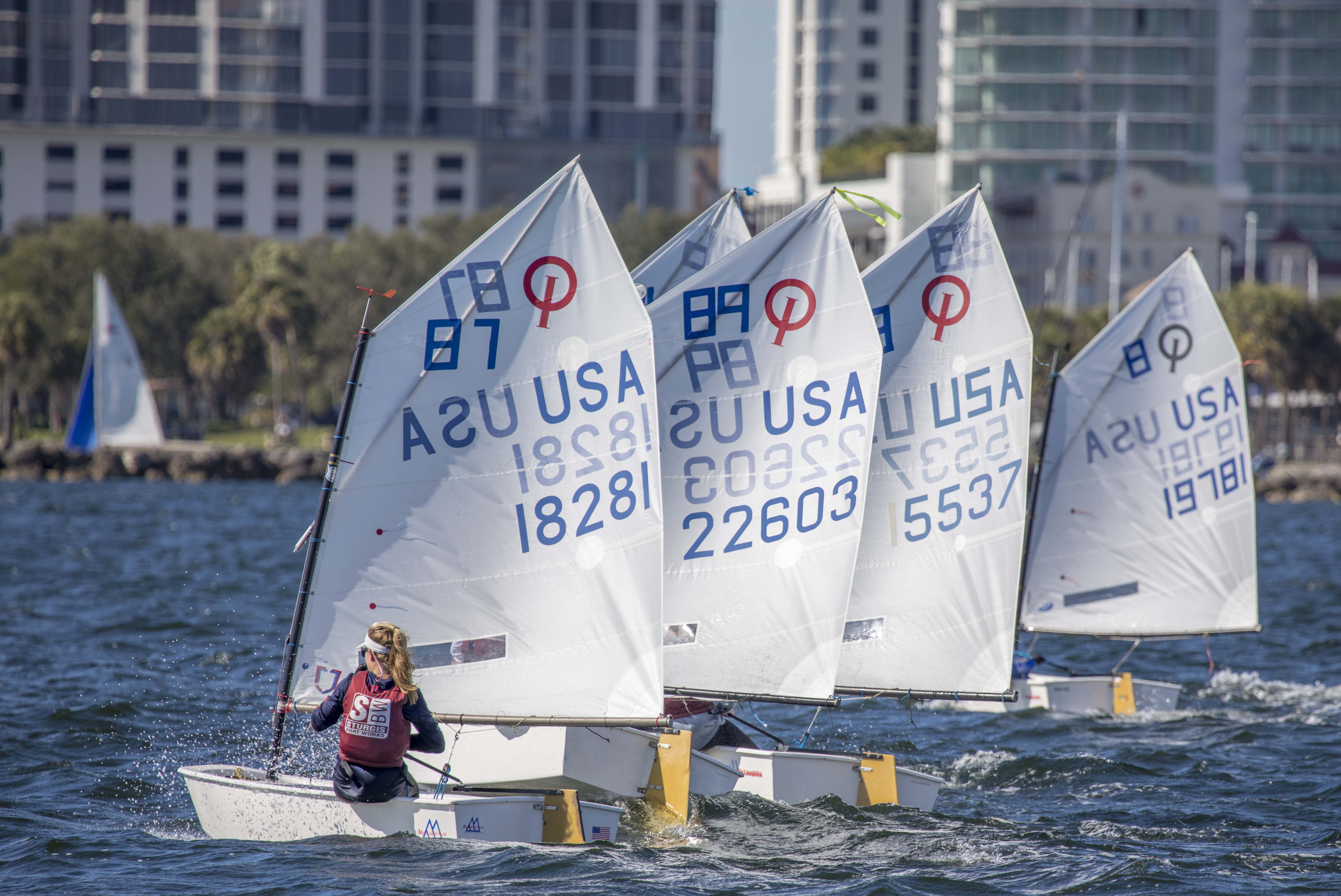
Youth Programs

Special Events
Since the 1940's.
The St. Petersburg Sailing Center has been home to novice sailors and expert racers since the early 1940's. Community memberships are available to those who live in the Tampa Bay Area.
Facebook Feed

We can't wait for the 2024-2025 Regatta Season! ... See More See Less
- Comments: 0
Comment on Facebook

🌊 Sailing for All! 🌍 At the St. Petersburg Sailing Center, we believe sailing should be accessible to everyone. Our community sailing programs offer affordable and inclusive opportunities for all ages and skill levels. Whether you’re looking to learn, race, or simply enjoy a day on the water, we have a program for you. 🤝 Community Sailing Includes: Open sailing days Special events and regattas ⛵️ Join our community and sail the beautiful waters of St. Pete! #sailstpete Learn more by visiting www.sailstpete.org ... See More See Less

🚤 It's Never Too Late to Learn! 🛟 Whether you're a seasoned sailor or a beginner, the St. Petersburg Sailing Center offers a variety of adult programs tailored to your experience level. From basic sailing lessons to advanced racing techniques, we've got you covered. 🌟 Membership Benefits Include: Access to a fleet of boats Discounted class fees Exclusive social events ⛵️ Explore our membership options and set sail with us! Learn more at www.sailstpete.org ... See More See Less

🌟 Setting Sail for the Future! 🌊 At the St. Petersburg Sailing Center, our youth programs are designed to inspire the next generation of sailors. From beginners to advanced sailors, our camps and classes offer a fun and educational experience on the water. Join us in creating lifelong memories and a love for sailing! 📅 Youth Programs: Summer Sailing Camps After-School Programs Competitive Sailing Teams ⛵️ Enroll your child today and let them discover the joy of sailing! Learn more by visiting www.sailstpete.org ... See More See Less
- Comments: 1
Would love to know more about your after school programs. My son enjoyed summer camp-would love to know what is available during the school year.
⛵️ Important Notice: Limited Hours and Equipment ⛵️ In preparation for impending inclement weather, our Sailing Center will have limited hours and equipment availability this weekend. We appreciate your understanding and cooperation during this time. Stay safe and we look forward to resuming normal operations soon! #SPYC #WeatherUpdate #sailstpete ... See More See Less

🌊 Save the Date! Ocean Racing Awards 🏆 Join us on August 17th at 6 PM for the Ocean Racing Awards. RSVP here: forms.gle/U7yXcYM39ofwmxno7 . Don't miss out! ... See More See Less

This summer, let your kids discover the joy of sailing at the St. Pete Sailing Center. Our camps are designed for all skill levels, ensuring a fun and educational experience for everyone. Don't let this summer pass by without a little adventure! #stpetesailingcenter #summercamp #sailingfun #stpeteadventures #sailstpete ... See More See Less

Looking for a unique summer experience for your kids? Our sailing camps at the St. Petersburg Yacht Club are the perfect blend of education and fun. From learning to rig boats to mastering the waves, every day is an adventure. Enroll today! #StPeteYachtClub #summersailing #youthsailing #AdventureAwaits #sailstpete ... See More See Less

Join us at the St. Petersburg Yacht Club for an unforgettable summer sailing camp! Perfect for young sailors ready to learn the ropes, make new friends, and have a blast on the water. Spots are filling up fast, so don't miss out! #StPeteYachtClub #summersailingcamp #youngsailors #stpetesummer #sailstpete ... See More See Less

It's hard to believe we are already half way through summer. Time flies when you are having fun! Don't miss out on the opportunity to learn how to sail this summer. Visit www.sailstpete.org for more information. #sailstpete #spycsailing #spyc_fl ... See More See Less

Thank you to the YMCA of Greater St. Petersburg for joining us on the water this summer! We are having a blast showing everyone the wonderful world of sailing. #sailstpete #spycsailing #spyc_fl ... See More See Less
- Comments: 2

We are incredibly proud of all of our amazing sailors. Learn how you can start your sailing journey by visiting www.sailstpete.org #spycsailing #spyc_fl #sailstpete ... See More See Less
- Comments: 3
We are excited for his next round of lessons! 🤗⛵️
Instagram Feed
Yachting World
- Digital Edition

America’s Cup boats: 8 facts about the AC75 and why they’re unique
- Toby Heppell
- August 20, 2024
The America's Cup boats to be used on the 2024 edition of the event are immensely complicated high tech bits of kit. They might be officially sailing craft but they behave in some remarkable ways

The AC75 is the class of boat that takes part in the America’s Cup and are arguably the most radical boats the compeition has ever seen. This type of America’s Cup boat was first used in the 2021 America’s Cup so this is the second event in which these boats have been used.
The America’s Cup is, fundamentally, a design competition, and successive America’s Cups have featured the most extreme yachts yet – for their time – ever since the first race in 1851.
However, the foiling boats we have seen in the last four editions of America’s Cup racing (the AC72 and AC50 catamarans, and now the AC75 monohulls) do represent a new direction for the highest level of sailing.
There are plenty who argue that this technology is so far beyond the bounds of what most people consider sailing as to be an entirely different sport. Equally, there are those who believe this is simply a continuation of the development that the America’s Cup has always pushed to the fore, from Bermudan rigs, to composite materials, winged keels, and everything in between.
Good arguments can be made either way and foiling in the world’s oldest sporting trophy will always be a subjective and controversial topic. But one thing is certain: the current America’s Cup boats, the AC75s, are unlike anything seen before and are showcasing to the world just what is possible under sail power alone.

Photo: Ian Roman / America’s Cup
1 Unimaginable speed
Topping the 50-knot barrier used to be the preserve of extreme speed record craft and kiteboarders. A World Speed Sailing Record was set in 2009 of 51.36 knots by Alain Thebault in his early foiling trimaran, Hydroptere , and was bested in 2010 by kite boarder, Alexandre Caizergues who managed 54.10 knots.
Only one craft has ever topped 60-knots, the asymmetric Vestas Sail Rocket 2 , which was designed for straight line speed only and could no more get around an America’s Cup course than cross an ocean. Such records are set by sailing an average speed over the course of 500m, usually over a perfectly straight, flat course in optimum conditions.
America’s Cup class yachts, designed to sail windward/leeward courses around marks, are now hitting speeds that just over a decade ago were the preserve of specialist record attempts, while mid-race. American Magic has been recorded doing 53.31 knots on their first version of the AC75 class, Patriot.
Perhaps even more impressive, in the right conditions when racing we have seen some boats managing 40 knots of boatspeed upwind in around 17 knots of wind. That is simply unheard of in performance terms and almost unimaginable just three or so years ago.
Article continues below…

How to watch the Louis Vuitton Cup Semi-Final – the America’s Cup challenger series streams
The America’s Cup Challenger Selection is set to continue on Saturday 14 September 2024, as the four teams that made…

WATCH: Will the USA’s Radical America’s Cup Design Choices Pay Off?
American Magic’s new AC75, Patriot, has garnered significant attention due to its unique approach. While all the teams are bound…
2 A storm onboard the AC75
Related to the speeds the boats are sailing through the water, particularly upwind, is the wind speeds the sailors will feel on deck.
When sailing, the forward motion affects the wind we experience onboard, known as apparent wind. The oft’ trotted out explanation of how apparent wind works is to imagine driving your car at 50mph. Roll down the window and stick your hand out of it and there will be 50mph of wind hitting your hand from the direction your car is travelling.
So when an AC75 is sailing upwind in 18 knots of breeze at a boatspeed of 40 knots, the crew on deck will be experiencing 40 knots of wind over the decks plus a percentage of the true wind speed – depending on their angle to the wind.
The AC75 crews might be sailing in only 18 knots of breeze – what would feel like a decent summer breeze on any other boat – but they experience winds of around 50 knots.
To put that into context, that is a storm force 10 on the Beaufort scale!

3 Righting moment changes
The single most radical development of the AC75 is to take a 75ft ‘keelboat’, but put no keel on it whatsoever.
When the then America’s Cup Defender and the Challenger of Record, Emirates Team New Zealand and Luna Rossa Prada Pirelli respectively, announced that the 36th America’s Cup (to be held in 2021) would be sailed in 75ft monohulls, conventional wisdom had it that the boats would look something like a TP52 or a Maxi72 – both impressively high performance keelboats.
By doing away with the keel entirely, the design is now like nothing we have ever seen, particularly when it comes to how dynamic the power transition is between foiling and not foiling.
The boats are designed to foil on the leeward foil, with the windward one raised to help increase righting moment: to help balance the boat. This means that when the AC75 is not foiling they are extremely tippy – much more so than most other boats of the same size.
Essentially, when the wind catches the sails, the boat wants to fall over as there is too much sail area for the amount of weight underneath the boat – something a lead keel usually counters on a yacht or keelboat.
Once the boat is up and on the foils, however, that all changes, as everything to windward of the single foil in the water balances the sails. That means, the hull, the crew weight, the sail and rig weight, and the windward foil, all work to counter the sails.
What all this means is that the boats go from being extremely tippy, to hugely powerful in just the few seconds it takes to get up on the foil. “The [AC75s] are really very tippy pre-foiling and then they go through the transition where they will need to build significant power. Then immediately [once they lift off] you have more stability than, well, take your pick, but certainly more righting moment than something like a Volvo 70 with a big canting keel.
“That change all happens in a very short space of time,” explained Burns Fallow of North Sails, who was one of the team who developed the soft wing concept back when the concept was revealed.

Photo: Ricardo Pinto / America’s Cup
4 ‘Cyclors’ return to power America’s Cup boats
Bak in 2017 Emirates Team New Zealand stormed to America’s Cup victory in an AC50 foiling catamaran which was, by some margin, quicker than any of the other teams.
The most glaring difference was their use of pedal grinders to produce power rather than traditional pedestal arm grinders. ETNZ’s sci-fi style term for their grinders was ‘cyclors’, cyclist sailors.
The idea had actually been tried before in the America’s Cup; Pelle Petterson used pedal grinders on the 12-metre Sverige in 1977. But ETNZ’s set-up now was very different: here it was part of a linked chain of innovations, the most obvious emblem of a radical approach.
One obvious benefit was the greater power output from using legs to pedal, but beyond this it left cyclists’ hands free and allowed the team to use a highly sophisticated system of fingertip control systems, and thus to use faster, less stable foils, and then to divide up crew roles so ETNZ could be sailed in a different way.
When the AC75 was first introduced in 2021, Cyclors were specifically banned by the class rule. However, with a reduction of crew numbers from 11 to 8 in the second AC75 class rule – in use for the 2024 America’s Cup – cyclors are now allowed once again and all teams look set to be using pedal power onboard.

5 America’s Cup boats may not be heading where they point
With the AC75 sailing on its foil, drag is dramatically reduced, vast amounts of power can be generated and so speeds rapidly increase. But the foils can serve another purpose too.
In order to be able to lift each foil out of the water, the foil arms must be able to be raised and lowered. Hence the foil wings, which sit at the bottom of the foil arms (and are usually a T or Y shape), do not always sit perpendicular to the water surface and the AC75s often sail with them canted over to something nearer 45º to the surface.
The further out the leeward foil arm is canted – essentially more raised – the closer the AC75 flies to surface and, crucially, the more righting moment is generated as the hull and rest of the boat gets further from the lifting surface of the foil.
There is another positive to this: as the lifting foil is angled, it produces lift to windward, which can force the boat more towards the wind than the angle it is sailing.
Due to this negative leeway (as it is known when a foil creates lift to windward) the boat can be pointing at a compass heading of say 180º but in fact will be sailing at eg 177º as the foil pushes the boat sideways and to weather, essentially sailing to windward somewhat diagonally.

6 The foils are heavy. Very heavy.
As the foils work to provide stability to the boat (when it is stationary both foils are dropped all the way down to stop it tipping over) and to provide massive amounts of righting moment, they are incredibly heavy.
A pair of foil wings and flaps (excluding the one-design foil arm which attaches them to the boat and lifts them up and down) weigh 1842kg. To put that into perspective, the entire boat itself with all equipment (but without the crew) weighs between 6200kg and 6160kg. So the foil wings at the base of the foil arms are nearly ⅓ of the total weight of the boat.
It is partly due to this that you will see some teams with bulbs on their foils. If you decide to go for a skinny foil wing (which would be low drag and so faster) then there will not be enough volume to cram sufficient material in to make the foil weigh enough. So some teams have decided to add a bulb in order to make it weigh enough but to also keep a less draggy, slimmer foil shape.

7 Sails can invert at the head
As with everything on the AC75, the mainsail was a relatively new concept when the boat was first announced. It consists of two mainsails which are attached to both corners of a D-shaped mast tube. This has the effect of creating a profile similar to a wing.
It is well established that solid wing sails are more efficient at generating power than a soft sail and for this reason solid wings were used in both the America’s Cup in 2013 and 2017. But there are drawbacks with a wing: they cannot be lowered if something goes wrong and require a significant amount of manpower and a crane to put it on or take it off a boat.
One reason a wing makes for such a powerful sail is that the shape can be manipulated from top to bottom fairly easily with the right controls. With the AC75 the designers wanted a sail that could have some of this manipulation, produce similar power but could also be dropped while out on the water. The twin skin, ‘soft wing’ is what they came up with for this class of America’s Cup boat.
In addition to the usual sail controls, within the rules, the teams are allowed to develop systems for controlling the top few metres of the mainsail and the bottom few metres.
What this means is that the teams are able to manipulate their mainsail in a number of different ways to develop power and control where that power is produced in the sail. But it also means that they have the ability to invert the head of the sail.
Doing this effectively means ‘tacking’ the top of the sail while the rest of the sail is in its usual shape. The advantage here is that instead of trying to tip the boat to leeward, the very top of the sail will be trying to push the boat upright and so creating even more righting moment. The disadvantage is that it would come at the cost of increased aerodynamic drag.
We know that a number of America’s Cup teams are able to do this, though whether it is effective is another question and it is very hard to spot this technique being used while the boats are racing at lightning speeds.

8 America’s Cup meets F1
A new America’s Cup boat is a vastly complex bit of kit. Each team has incredibly powerful Computational Fluid Dynamics (CFD) software packages and simulators in order to try to understand the various gains and losses.
To make these simulators and computer projections as accurate as possible each team has been getting as much data as they can over their three year development cycle.
In the case of this America’s Cup it does seem the development process is genuinely getting closer to Formula 1 (albeit with smaller budgets than a modern F1 team has behind them).
INEOS Britannia have been work alongside the all powerful Mercedes F1 team (both of who are backed by INEOS) and have been open about how much this has helped their development process and after a relatively small amount of collaboration in 2021 the British team and Mercedes have created a much tighter relationship for the 2024 America’s Cup .
But the British team is not alone. When two-time America’s Cup winner, Alinghi announced they would be coming back to the event after some years on the sidelines, they also announced their own tie-in with current F1 World Champions, Red Bull Racing, to for Alinghi Red Bull Racing .
“It’s really similar to F1,” explains Mercedes Applied Science Principal Engineer Thomas Batch who has 11 F1 titles to his name and is was with INEOS in Auckland 2021. “Certainly in this campaign the technology is close to what we have in F1.
“In terms of raw sensors on the boat you are probably talking in the 100s but then we take that and we make that into mass channels and additional analysis with computational versions of those channels that we then analyse and get into in more detail. So you are looking at 1000s of plots that we can delve into [per race or training session].
“That level of data analysis and then feedback with the sailors is very similar to working with an [F1] driver.”
If you enjoyed this….
Yachting World is the world’s leading magazine for bluewater cruisers and offshore sailors. Every month we have inspirational adventures and practical features to help you realise your sailing dreams. Build your knowledge with a subscription delivered to your door. See our latest offers and save at least 30% off the cover price.
- Print This Page
- Text Size
- Scroll To Top

* The Long Island SS Class Association *

- AROUND THE SAILING WORLD
- BOAT OF THE YEAR
- Email Newsletters
- America’s Cup
- St. Petersburg
- Caribbean Championship
- Boating Safety
- Ultimate Boating Giveaway

- Regatta Series
St. Pete To Shine Again
- By Dave Reed
- February 14, 2024
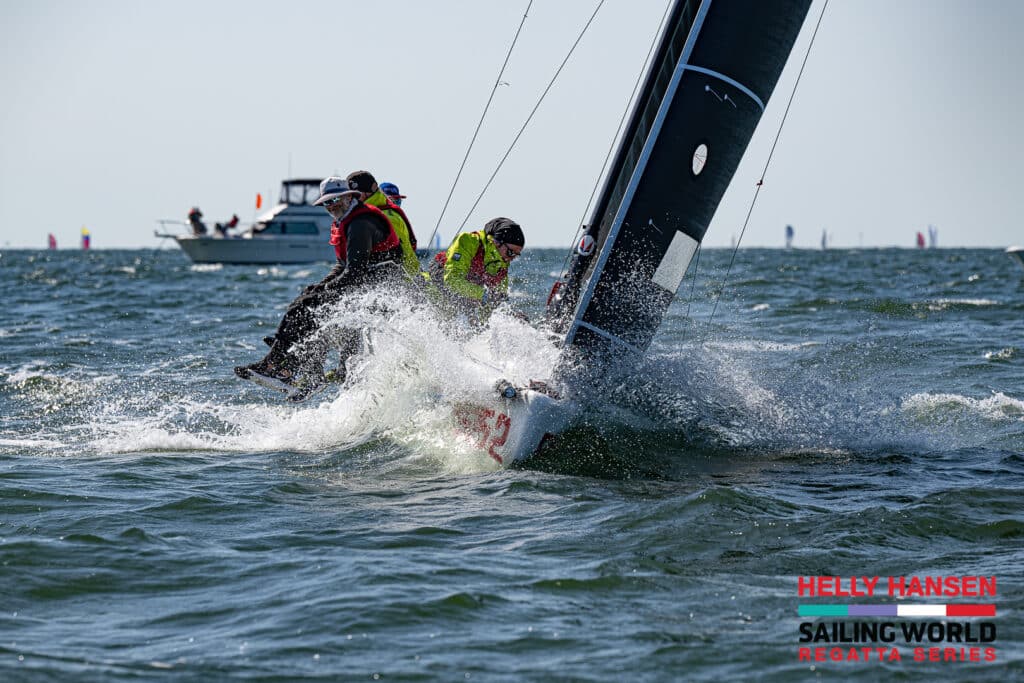
The St. Petersburg Yacht Club and the western shore of Florida’s Tampa Bay will be the epicenter of sailboat racing this weekend when more than 240 teams across 13 one-design classes and five handicap-racing fleets get races started for the first event of the national Helly Hansen Sailing World Regatta Series in St. Petersburg . Now well into its third decade, the regatta will also mark 10 years with its title sponsor.
The Sunshine City’s motto is that St. Pete is “Always in Season,” and that is certainly the enticement for many teams traveling in from colder climes with the promise of warm breezes, stiff competition and a nightlife that’s never been more vibrant.
One such northerner is David Mierzwa, of Lake Placid, New York, who on Tuesday was behind the wheel and racing to get south of a big storm burying the mid-Atlantic and Northeast in snow and ice. Behind him was bitter cold, but ahead of him was warmth and the anticipation of his first Melges 24 Midwinter Championship at the regatta.
As a newbie to the demanding Melges 24, Mierzwa says his primary goal is to “stay out of everybody’s way,” but ultimately, he and his teammates are on a mission to learn the nuances of this high-performance keelboat from his peers.
“We’re going so we can hunt for tips, tricks and whatever makes us better,” Mierzwa says. “It’s about having the opportunity to do an event of this caliber with likeminded people, because while sailing is the goal, being surrounded by others that do the same sport is sometimes better than the sport itself.”
As the Helly Hansen Sailing World Regatta in St. Petersburg will be his team’s first major event, he recognizes they don’t have a high enough racing pedigree to vie for the Midwinter Championship title—yet. “The only way we can get to that point is to go out there and race,” he says.
And race they will, from early Friday morning through late Sunday, alongside several other one-design classes that are the regulars of this February classic, including the S2 7.9s and the Hobie 33s , both of which will also be vying for their midwinter championship titles.
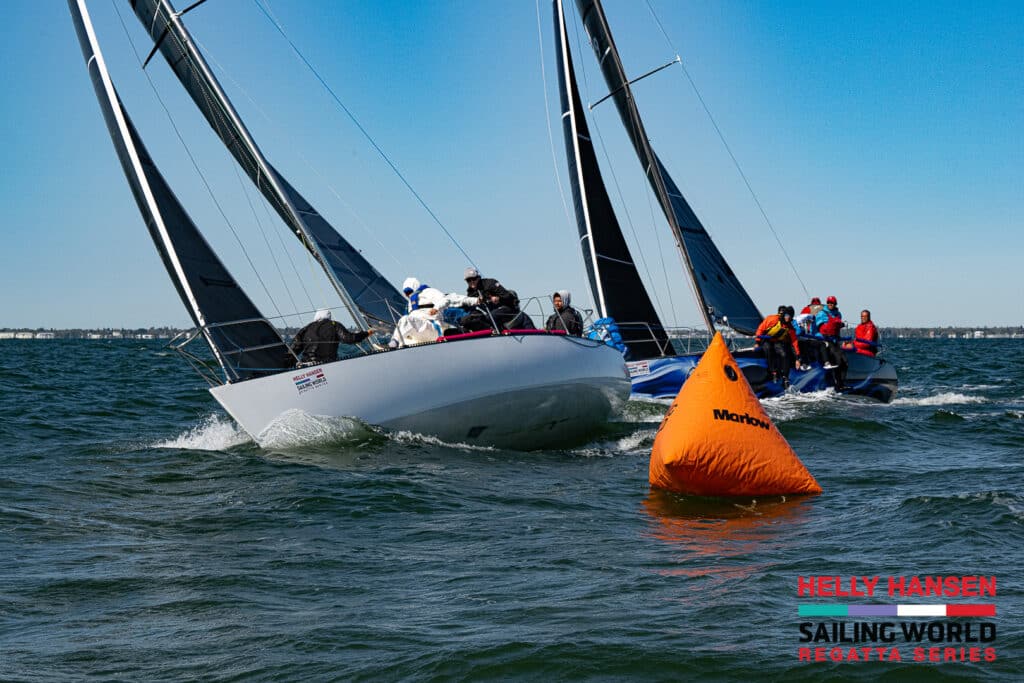
The S2s have the returning champions of Tom and Mary Bryant’s “Team Matros” from Holland, Michigan, which won seven of eight races in 2023 to earn their berth at the Helly Hansen Sailing World Caribbean Championship last October. At each of the series’ five events one team is selected to compete in the British Virgin Islands for the overall season title.
The Hobie 33s also have their champions returning to defend— Craig and Deborah Wilusz’s “Hoof Hearted”—but this year there’s a new and unknown challenger from Waxhaw, North Carolina, and it’s a boat with a nefarious name: “Bad Bunny.” Its new owner, Sean Rhone, says he’s looking forward to meeting and racing with other Hobie 33 owners for the first time and “taking a peek under their hoods.”
Rhone has been primarily racing his Hobie 33 in singlehanded events and low-key races on North Carolina’s Lake Norman, and like Mierzwa, he’s not sure how well he’ll fare, especially with a five-person team that’s been assembled by way of social media message boards, and whom he’s never met.
“It’s cold in Charlotte,” Rhone says, “and I’m getting tired of the cold weather, so when I saw that the fleet was having its midwinters in St. Petersburg, I thought it would be nice to go and race against some other Hobie 33s for once.”
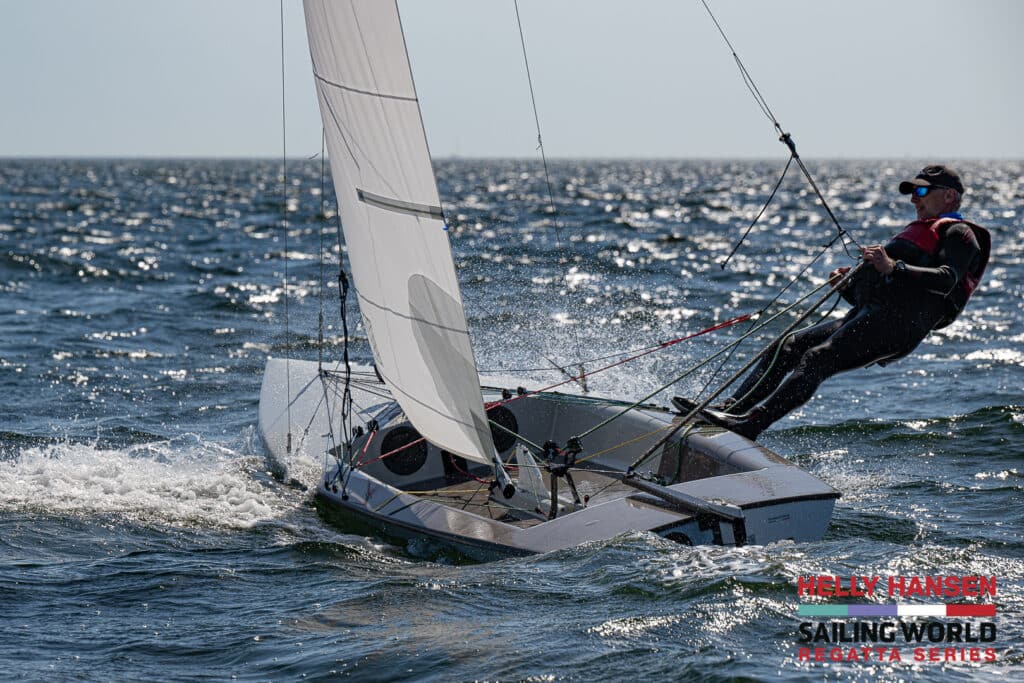
Mierzwa and Rhone may pass each other on an interstate somewhere on the way to St. Pete, along with a sizable Canadian contingent of Contender dinghy sailors making their annual pilgrimage from across the northern border. The 16-foot Contender, which its loyalists claim to be “The Sexiest Singlehander in the World ” was introduced in 1969 and continues to be popular internationally, as well as in Tampa thanks to local sailmaker Ethan Bixby. Bixby, a champion of many classes, continues to rally the troops to the Helly Hansen Sailing World Regatta and the fleet has doubled for this year’s gathering. Bixby, who won all races last year, will of course be among the 11 trapezing sailors.
Sharing the same racecourse will be eight teams racing the doublehanded Windmill class, which is new to the regatta lineup, but another cult classic sparked in the 1950s. Class measurer Pat Huntley, of Erie, Pennsylvania, is now a decade into Windmill racing, and says he’s eager to enjoy some fast sailing in St. Pete and good times with his fellow Windmillers. “It’s such a fun and cool group,” Huntley says. “And the Windmill is such a bad-ass skinny and fast boat. It can handle the chop easily and is really fast.”
Five teams racing in the 20-foot Flying Dutchman class (first built in 1951) will hail from California to Tennessee and hosted by local FD ace, Lin Robson, the 2023 class winner. The doublehanded bonanza, however, will be the Melges 15 class, which will feature an impressive 31 teams, nearly double from 2023. The new one-design class has exploded in popularity across the country since its introduction three years ago, and midwinter regattas elsewhere in Florida have maxed out at nearly 100 boats.
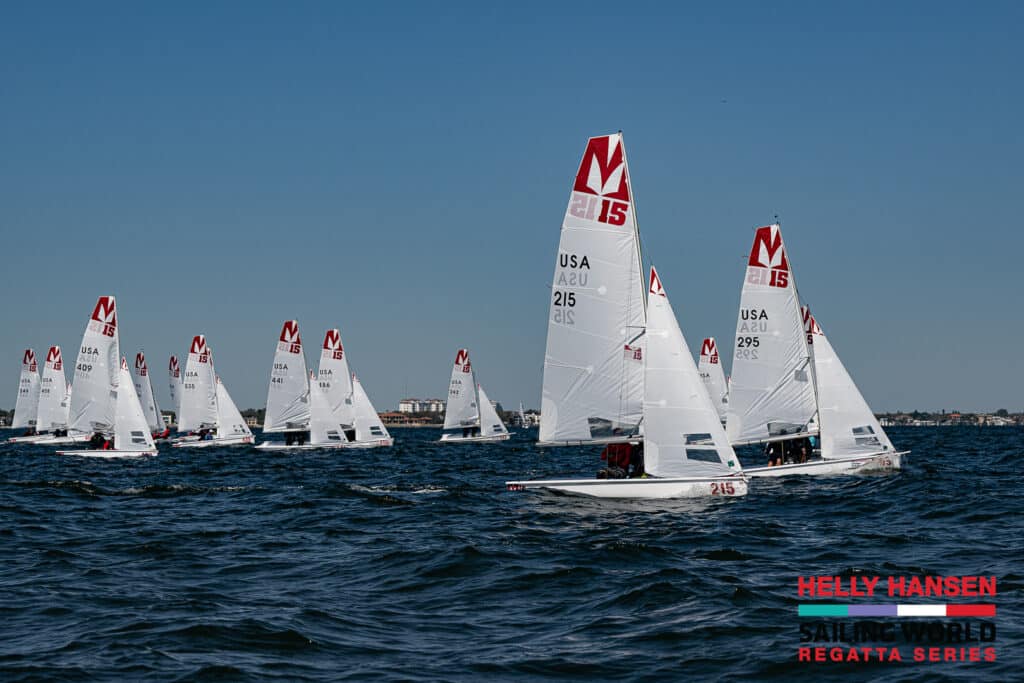
Among the Melges 15 ranks in St. Petersburg will be New York’s Iris Vogel, who has traditionally raced the regatta with her larger one-design keelboats over the years (a Soverel 33 and a J/88, both named “Deviation”). Vogel is now enjoying the challenge of big-fleet racing and exhilarating downwind sailing.
Racing with her partner, Tim Longo, Vogel helms and Longo handles the front of the boat, and over the past year they’ve been working their way up the scoreboard, but have a long way to go to the top. “This is a totally new thing to sail in such a big fleet,” Vogel says. “J/88 events typically get a dozen boats at best, and the racing is much slower paced. The tactics are completely different and boats are fast downwind so it’s a ton of fun, but we are still learning a different style of racing. Having the smaller fleet [at the Helly Hansen Regatta] will give us a chance to work on our boatspeed.”
While the out-of-town armada is significant, local sailors look forward to the regatta every year, especially Tampa Bay’s PHRF sailors who’ve made the event a key fixture in their Suncoast Boat of the Year Series. For these fleets, which now comprise the regatta’s largest group with 38 entries across four divisions (Spinnaker, Non-Spinnaker, Racer-Cruiser and Cruising) organizers have added two days of long-course racing over the weekend. Depending on the wind strength and direction of the day, the race committee will plot a daylong course to test each team’s navigational and sailing skills, as well as their perseverance and desire to be first to the dock and first to the yacht club bar.
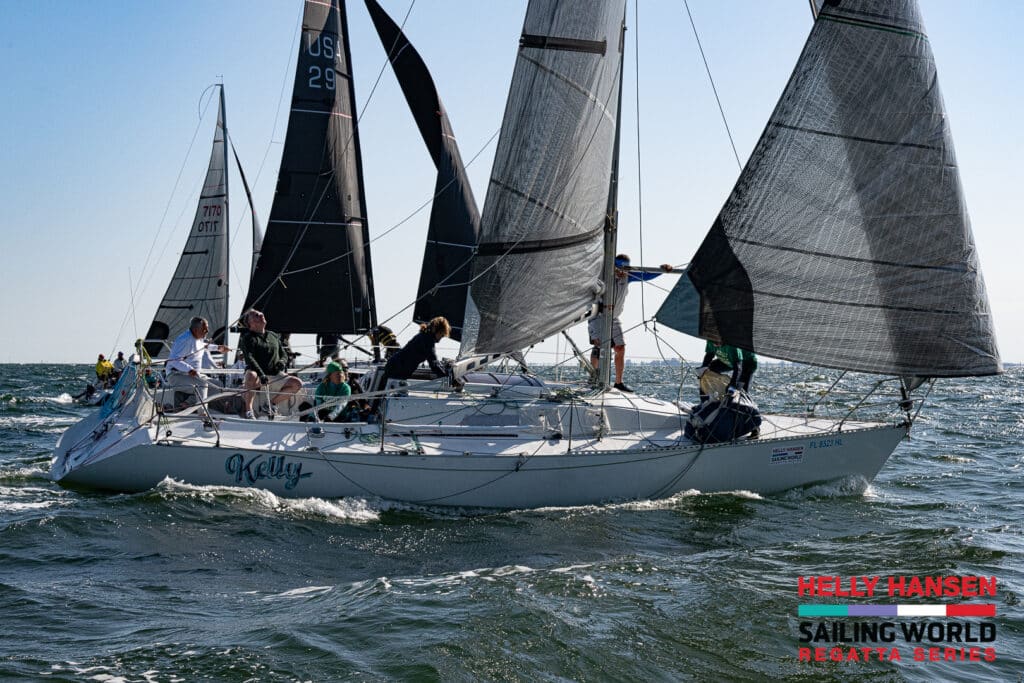
Local sailor Tim Landt, who has been an active sailor on the Tampa Bay waterfront for decades, is a registered competitor in the Cruising division in his new-to-him Nightwind 35, “Charisma.” He’s excited to see the regatta’s blossoming distance-race fleet and says the local growth and interest in racing older-generation yachts is good for the sport and for the Tampa Bay racing scene.
But it’s not all classic plastics in the distance fleet. In the Racer-Cruiser division will be the sparkling new Neo 43, owned by Ken Mungan of nearby Isles Yacht Club in Punta Gorda, Florida. Mungan purchased his sleek Italian-built 43-footer in 2022 with big plans to take on a few of the sport’s marque distance races, and local events like the Helly Hansen Sailing World Regatta offer he and his team an opportunity to learn the boat in a racing environment.
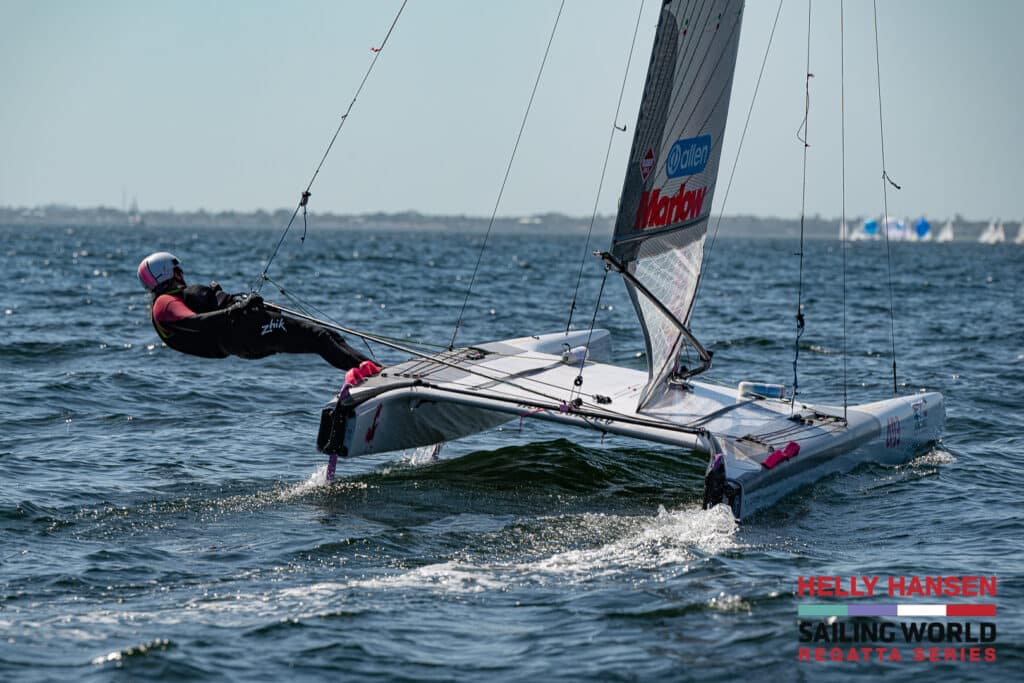
“When I turned 40 I needed a hobby and took up sailing,” Munger says. “I’m always trying new things and got into racing 2019. I did the Melges 24 for a while, but the Neo, because it’s a shallow-draft boat, allows me to do more local long-distance racing and we’re learning a lot.”
For this weekend’s regatta, Munger has more crew lined up than there are roles on the boat, but that’s fine with him. “We’re going to be overloaded, and I am anticipating a level of skill and organization that we don’t quite have yet,” he admits. “We’ll have two coaches and a new set of racing jibs that will be used for the first time, so it will be fun, and I’m looking forward to it.”
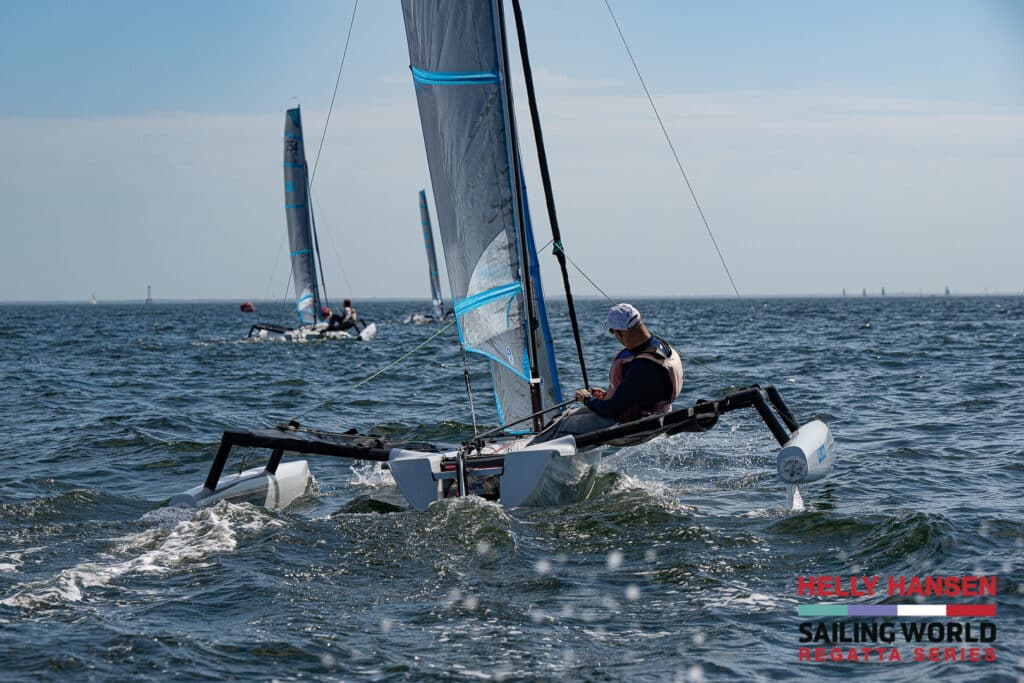
While the long-course racers are making their way around the bay, closer to shore, will be the multihulls: the high-tech A Class Catamarans , which have two divisions (Classic and Foiling) totaling 33 competitors, and the Weta Trimarans , with a smaller contingent from years past, return with nine boats, and among them is two-time defending champion and local Pete Merrifield looking for a three-peat.
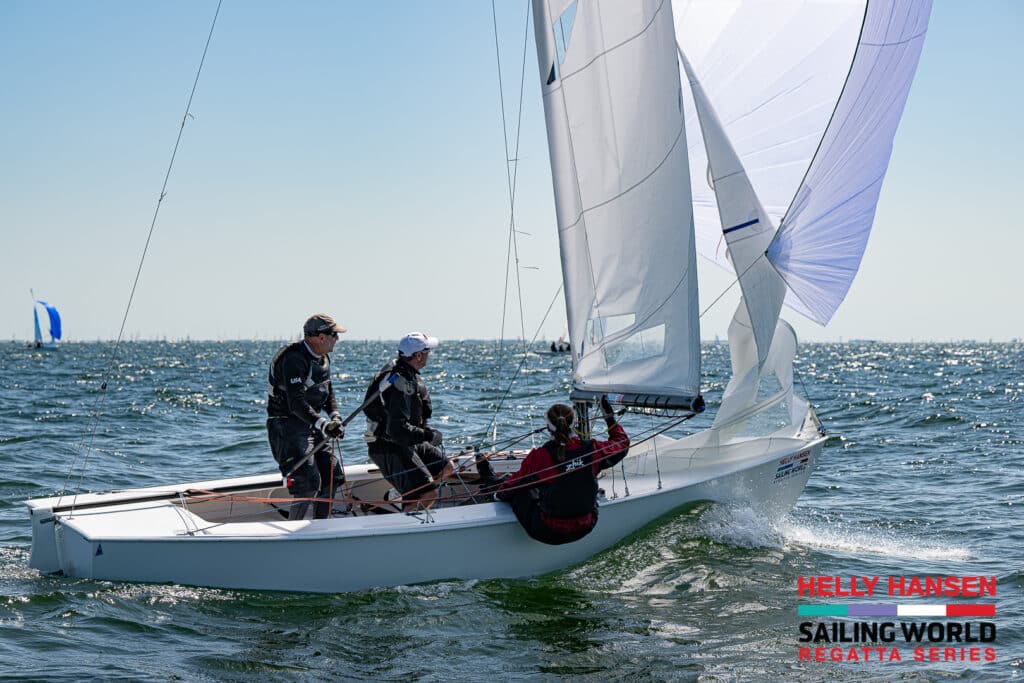
The iconic Lightning Class is one of the regatta’s largest one-design fleets, with 25 boats, five of which will be raced by members of the Starck family with a few world champions among them. Hall of Famer, Augie Diaz, of Miami, and Ched Proctor, of Southport, Connecticut, both world champions as well, always add to the high level of racing and camaradarie Lightning sailors enjoy all winter. The Helly Hansen Sailing World Regatta in St. Petersburg is a key warm-up event for the Lightning class’s hotly-contested two-regatta Southern Circuit with March events in St. Pete and Miami.
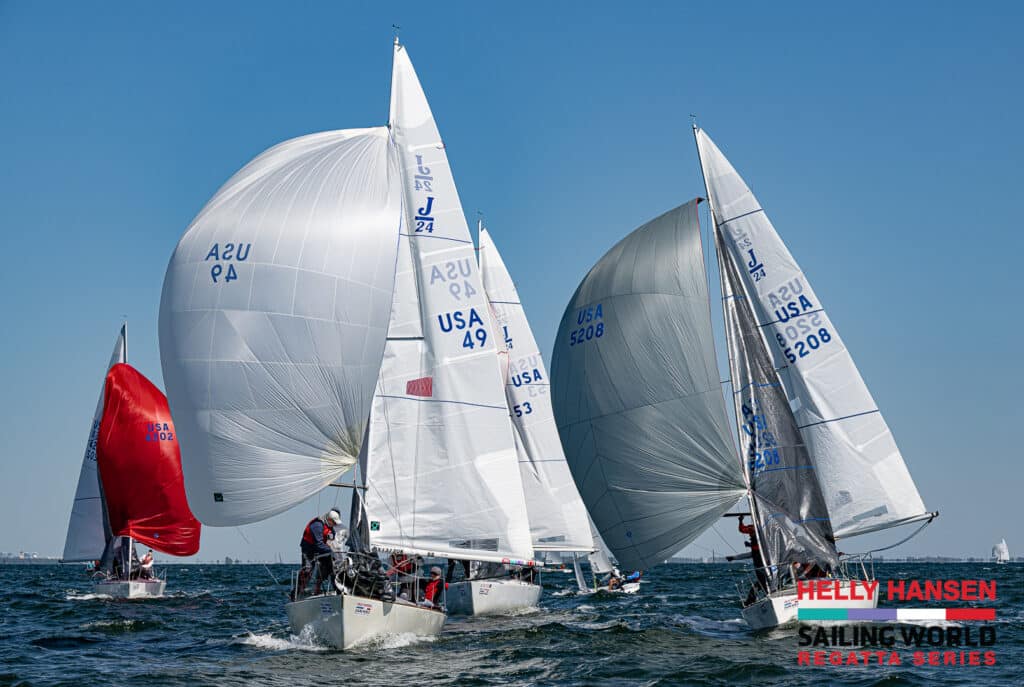
Sharing one racing circle immediately off the city front will be the 29-boat J/70 fleet and a reemergent J/24 fleet, both of which will no doubt provide quality racing for both professional and amateur sailors. The same will be true for the ever-competitive ORC fleet, with 11 entries, which will be racing further south. Bill and Jackie Baxter’s J/111 “Fireball,” from Stamford, Connecticut, which has won all of its events this winter will return to defend its 2023 ORC title, which it earned with ease, winning seven of eight races.
- More: Helly Hansen Sailing World Regatta Series , Helly Hansen Sailing World Regatta Series St. Petersburg
- More Regatta Series
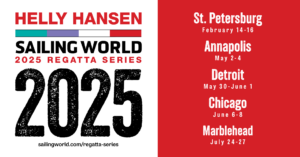
Helly Hansen Sailing World Regatta Series Dates Announced
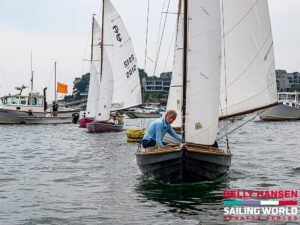
Townie Showdown in the Harbor
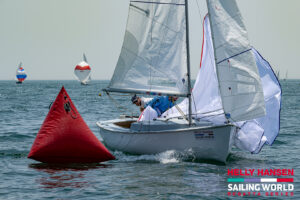
Haves and Have Nots On Marblehead Regatta’s Second Day
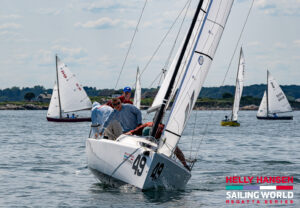
Regatta Series In Marblehead Starts With a Twist
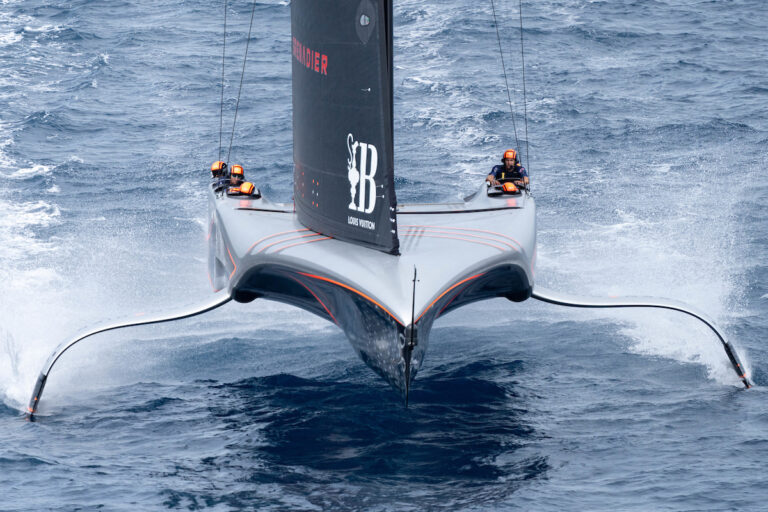
Barcelona Breeze Increase Spikes Intensity

Luna Rossa Dominant on Busy Day in Barcelona
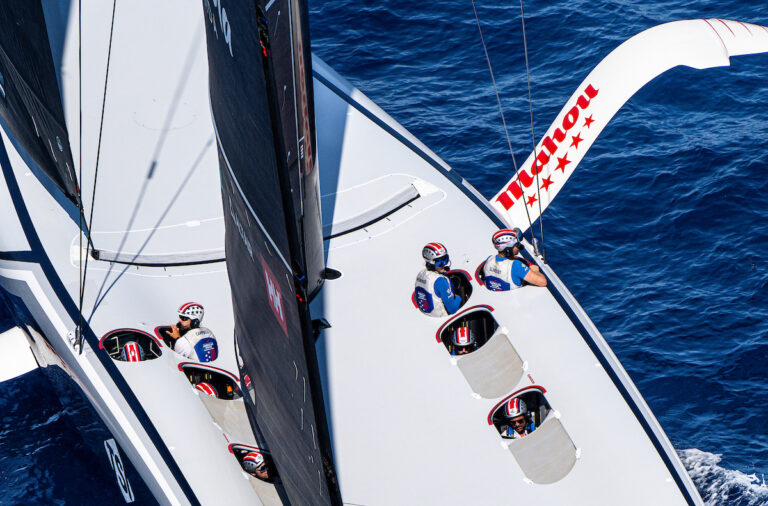
One and Done on Drifter Day of Cup Challenger Series
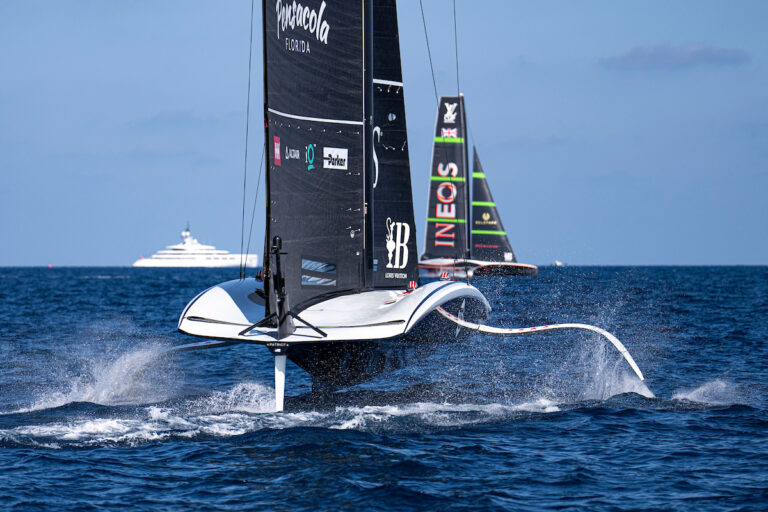
Shocks and Drops At Louis Vuitton Cup Start

- Digital Edition
- Customer Service
- Privacy Policy
- Terms of Use
- Cruising World
- Sailing World
- Salt Water Sportsman
- Sport Fishing
- Wakeboarding

IMAGES
VIDEO
COMMENTS
S#: S# first appeared (that we know of) in TellTales, April 1988, "On a Scale of One to Ten" by A.P. Brooks . The equation incorporates SA/Disp (100% fore triangle) and Disp/length ratios to create a guide to probable boat performance vs. other boats of comparable size. For boats of the same length, generally the higher the S#, the lower ...
The S Class Centennial Herreshoff Classic Regatta, held at the Herreshoff Marine Museum in Bristol, Rhode Island last August 2019 highlighted the S-Class in honor of its anniversary. As many as 28 of these splendid yachts participated in the event. Transcending the competition of the races, the splendor of such a large fleet of magnificent S ...
Herreshoff S-Class is a 27′ 5″ / 8.4 m monohull sailboat designed by Nathaniel G. Herreshoff and built by Lawley (George Lawley & Son) and Herreshoff Mfg. Co. between 1919 and 1941. ... The higher a boat's D/L ratio, the more easily it will carry a load and the more comfortable its motion will be. The lower a boat's ratio is, the less ...
1919 Herreshoff S Boat, Bristol, RI, $74,999. Presenting PAPOOSE, a special centennial member of the Herreshoff S-Class. The Herreshoff S-Class is highly regarded as one of the most beautiful one-designs ever. It's an instantly recognizable classic with its spoon bow, Herreshoff cabin trunk, and sharply curved mast carrying a large marconi ...
Captain Nat's son, L. Francis Herreshoff, once stated that there have been few all-around better boats for afternoon sailing, cruising and racing than the S Class, also noting they were also the last one-design class that was somewhat comfortable, and perhaps the most interesting design developed in 1919, amidst all of the innovation going on ...
100 YEARS OF THE S-CLASS Classic Boat | January 2020 A century on and more than half of the original boats are still racing and sailing - we take a closer look at Herreshoff's enduring design - ALAN SILKEN Every summer since 1920, spirited small yachts have given their sailors that special feeling, that contented smile that comes from crossing the bay, tiller in hand, at the helm of a ...
17. Contact. 401-619-2888. 1. Sort By. Filter Search. View a wide selection of Herreshoff S Class boats for sale in your area, explore detailed information & find your next boat on boats.com. #everythingboats.
Two S boats (S-42 and S-47) conducted combat patrols in 1944 with the last combat patrol by an S boat being conducted by S-42 from 5 August to 3 September 1944. In World War II, S-class boats did not use the newer Mark 14 torpedo, standard in fleet submarines, due to shorter torpedo tubes, relying on the World War I-vintage Mark 10 instead ...
The 51 submarines of this class comprised the largest single class of submarine in the U.S. Navy until WWII, and it made up the bulk of our Navy's submarine force during the 1920's and 30's. Some of the S-boats served right up to the end of WWII, an unthinkable longevity for the time.
A VISUAL GUIDE TO THE S-CLASS SUBMARINES 1918-1945 PART 1: THE PROTOTYPES DAVID L. JOHNSTON. 918-1945 PART 1: THE PROTOTYPES(2nd Edition, June 2011)BYDAVID L. JOHNSTON 2010/2011Throughout the rich history of the United States Navy Submarine Service, there are se. eral submarines that have become iconic and are among the first mentioned in ...
30. Swan 44. A strong, robust cruising boat built for high-seas, blue water adventures, the Swan 44 was designed by Sparkman & Stephens, and the yacht's well-known Finnish manufacturers, Nautor Swan, produced 76 boats in a production run that lasted from 1972-1975.
9 S-48 through S-51 (Modified Government design built by Lake Torpedo Boat Company) 10 S-class general and group photos; Design and Construction Notes. The 51 S-class open ocean patrol submarines marked the transition away from the harbor and coastal defense strategic concept that had dominated USN submarine doctrine since 1900. The concept ...
Development class: Dart 18: Formula 16: Development class: Formula 18: Development class: Hobie 14: Hobie 16: Hobie 17: 1985: John Wake: Hobie Cat: Hobie Dragoon: Hobie Tiger: 1995: Hobie Cat Europe: Hobie Cat Europe Hobie Cat [56] Hobie Wildcat: M32: 2010: Göran Marström/Kåre Ljung: Aston Harald Composite AB: Nacra 20: 1998: Morrelli ...
one mast. triangular mainsail (called a Bermuda sail) a foresail (also called the jib) fore-and-aft rigged. medium-sized (12 - 50 ft) Fore-and-aft rigged just means "from front to back". This type of rigging helps to sail upwind. Any sailboat with one mast and two sails could still be a sloop.
St. Petersburg Sailing Center. 3 weeks ago. Important Notice: Limited Hours and Equipment. In preparation for impending inclement weather, our Sailing Center will have limited hours and equipment availability this weekend. We appreciate your understanding and cooperation during this time. Stay safe and we look forward to resuming normal ...
The AC75 is the class of boat that takes part in the America's Cup and are arguably the most radical boats the compeition has ever seen. This type of America's Cup boat was first used in the ...
Jeanneau Sun Odyssey 350. 2024. Request Price. Successor to the Sun Odyssey 349, a tremendous success, this efficient, easy-to-handle cruising sailboat features clever innovations for the comfort of all on board and for the pleasure of sailing. The Sun Odyssey 350 features a distinctive, contemporary silhouette.
The club was founded in 1937 by a group of sailboat owners who came together to race these classic wooden boats. Since many boats had been built already, the original members felt it necessary to maintain the status of these Small Sloops as a one-design racing class, by insuring that all SS boats (or yachts purporting to be SS boats) would be built only from the official designs and moulds.
Other great trainers include American Sail Inc.'s American 18 and 14.6, Cape Cod Shipbuilding Co.'s Bull's Eye, Mercury, Rhodes 19 and Uffa Fox-designed DaySailer, and the various boats at the smaller ends of the Catalina and Hunter lines, including the Catalina Expo 16.5 and the Hunter 15. The list goes on and on.
The Helly Hansen Sailing World Regatta in St. Petersburg is a key warm-up event for the Lightning class's hotly-contested two-regatta Southern Circuit with March events in St. Pete and Miami. J ...
S#: S# first appeared (that we know of) in TellTales, April 1988, "On a Scale of One to Ten" by A.P. Brooks . The equation incorporates SA/Disp (100% fore triangle) and Disp/length ratios to create a guide to probable boat performance vs. other boats of comparable size. For boats of the same length, generally the higher the S#, the lower ...
S-class torpedo boat. The Finnish S-class torpedo boats was a series of six ex- Russian torpedo boats that had been taken over by the Finns after the Russian Revolution and the Finnish Civil War . S1 through S5 belonged to the Russian Sokol -class torpedo boat destroyers, while S6 was of the smaller Modified Ussuri class (also called Modified ...
A change in this year's rules has given rise to a special class of sailors known as "cyclors," who generate enormous power with their legs to move the controls of some of the world's ...